Research Project - Assignment PDF
VerifiedAdded on 2021/05/31
|33
|6626
|22
AI Summary
Contribute Materials
Your contribution can guide someone’s learning journey. Share your
documents today.
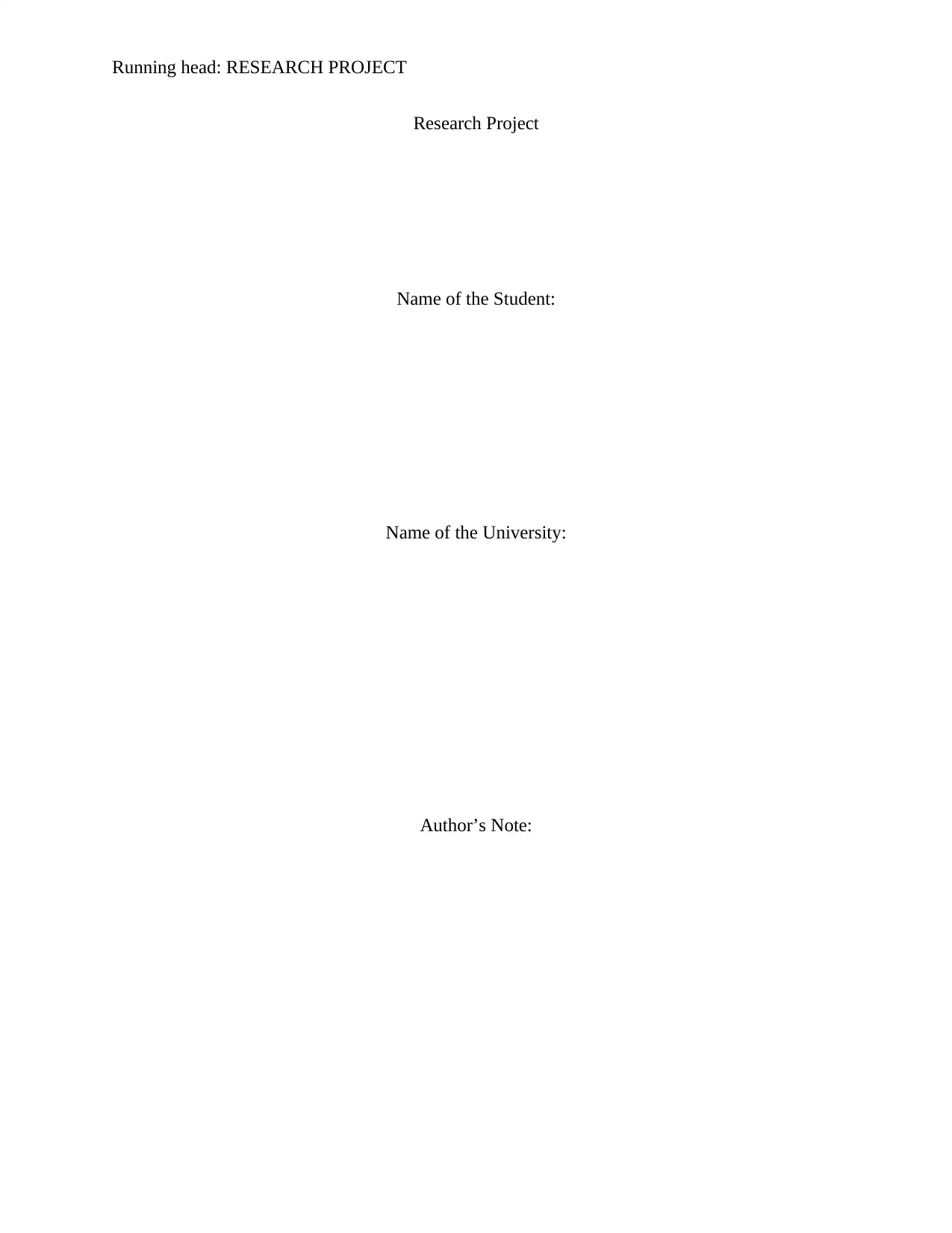
Running head: RESEARCH PROJECT
Research Project
Name of the Student:
Name of the University:
Author’s Note:
Research Project
Name of the Student:
Name of the University:
Author’s Note:
Secure Best Marks with AI Grader
Need help grading? Try our AI Grader for instant feedback on your assignments.
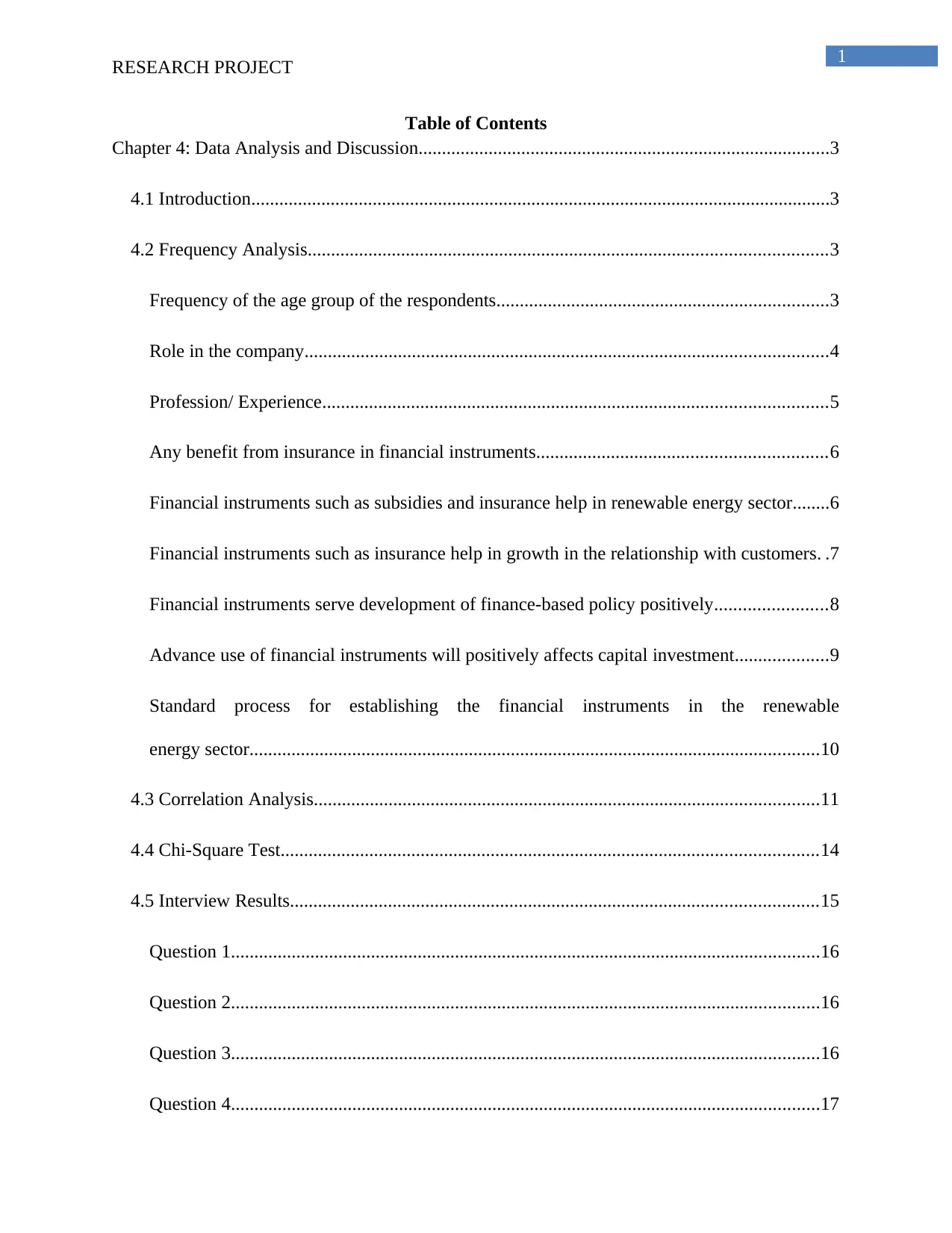
1
RESEARCH PROJECT
Table of Contents
Chapter 4: Data Analysis and Discussion........................................................................................3
4.1 Introduction............................................................................................................................3
4.2 Frequency Analysis...............................................................................................................3
Frequency of the age group of the respondents.......................................................................3
Role in the company................................................................................................................4
Profession/ Experience............................................................................................................5
Any benefit from insurance in financial instruments..............................................................6
Financial instruments such as subsidies and insurance help in renewable energy sector........6
Financial instruments such as insurance help in growth in the relationship with customers. .7
Financial instruments serve development of finance-based policy positively........................8
Advance use of financial instruments will positively affects capital investment....................9
Standard process for establishing the financial instruments in the renewable
energy sector..........................................................................................................................10
4.3 Correlation Analysis............................................................................................................11
4.4 Chi-Square Test...................................................................................................................14
4.5 Interview Results.................................................................................................................15
Question 1..............................................................................................................................16
Question 2..............................................................................................................................16
Question 3..............................................................................................................................16
Question 4..............................................................................................................................17
RESEARCH PROJECT
Table of Contents
Chapter 4: Data Analysis and Discussion........................................................................................3
4.1 Introduction............................................................................................................................3
4.2 Frequency Analysis...............................................................................................................3
Frequency of the age group of the respondents.......................................................................3
Role in the company................................................................................................................4
Profession/ Experience............................................................................................................5
Any benefit from insurance in financial instruments..............................................................6
Financial instruments such as subsidies and insurance help in renewable energy sector........6
Financial instruments such as insurance help in growth in the relationship with customers. .7
Financial instruments serve development of finance-based policy positively........................8
Advance use of financial instruments will positively affects capital investment....................9
Standard process for establishing the financial instruments in the renewable
energy sector..........................................................................................................................10
4.3 Correlation Analysis............................................................................................................11
4.4 Chi-Square Test...................................................................................................................14
4.5 Interview Results.................................................................................................................15
Question 1..............................................................................................................................16
Question 2..............................................................................................................................16
Question 3..............................................................................................................................16
Question 4..............................................................................................................................17
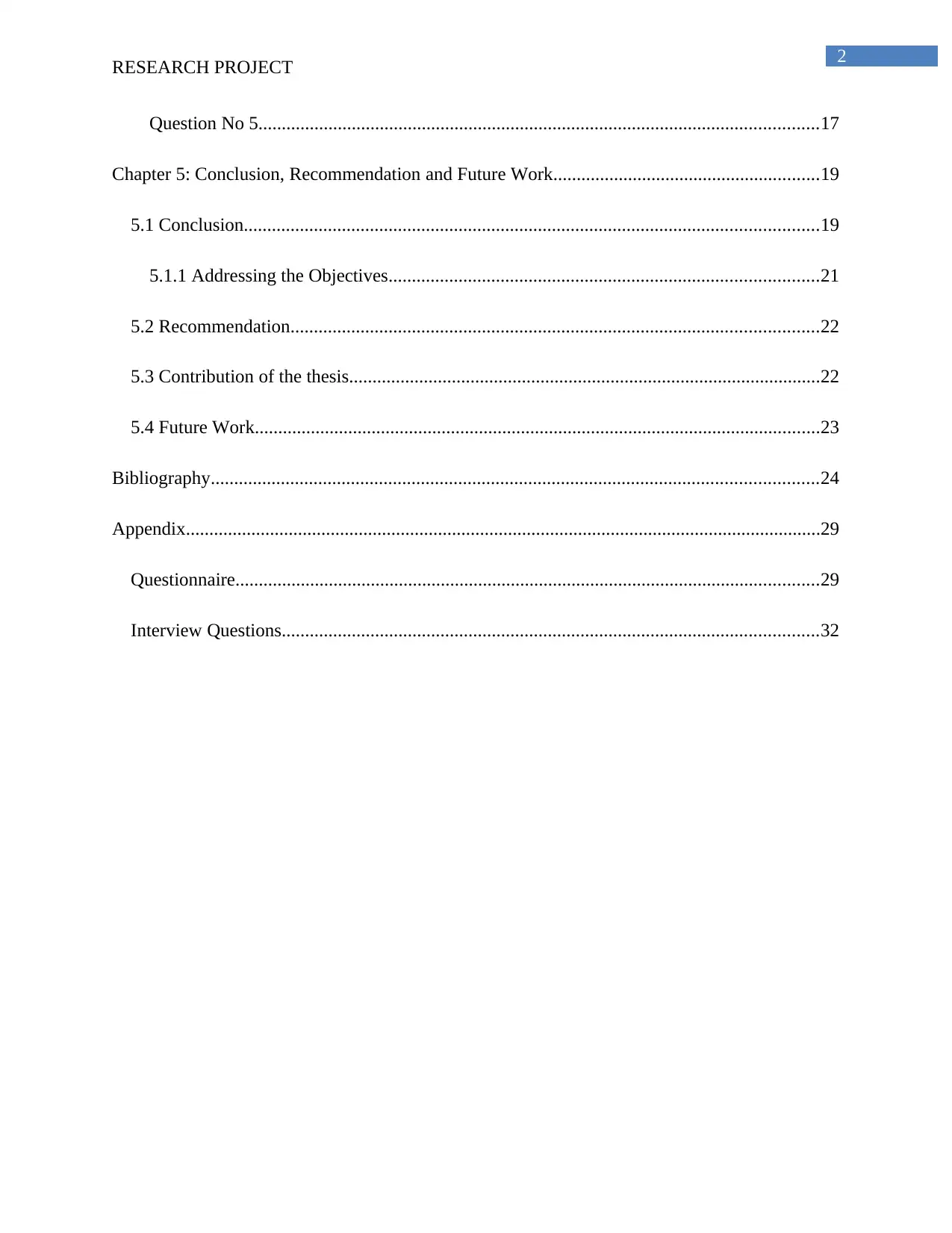
2
RESEARCH PROJECT
Question No 5........................................................................................................................17
Chapter 5: Conclusion, Recommendation and Future Work.........................................................19
5.1 Conclusion...........................................................................................................................19
5.1.1 Addressing the Objectives............................................................................................21
5.2 Recommendation.................................................................................................................22
5.3 Contribution of the thesis.....................................................................................................22
5.4 Future Work.........................................................................................................................23
Bibliography..................................................................................................................................24
Appendix........................................................................................................................................29
Questionnaire.............................................................................................................................29
Interview Questions...................................................................................................................32
RESEARCH PROJECT
Question No 5........................................................................................................................17
Chapter 5: Conclusion, Recommendation and Future Work.........................................................19
5.1 Conclusion...........................................................................................................................19
5.1.1 Addressing the Objectives............................................................................................21
5.2 Recommendation.................................................................................................................22
5.3 Contribution of the thesis.....................................................................................................22
5.4 Future Work.........................................................................................................................23
Bibliography..................................................................................................................................24
Appendix........................................................................................................................................29
Questionnaire.............................................................................................................................29
Interview Questions...................................................................................................................32
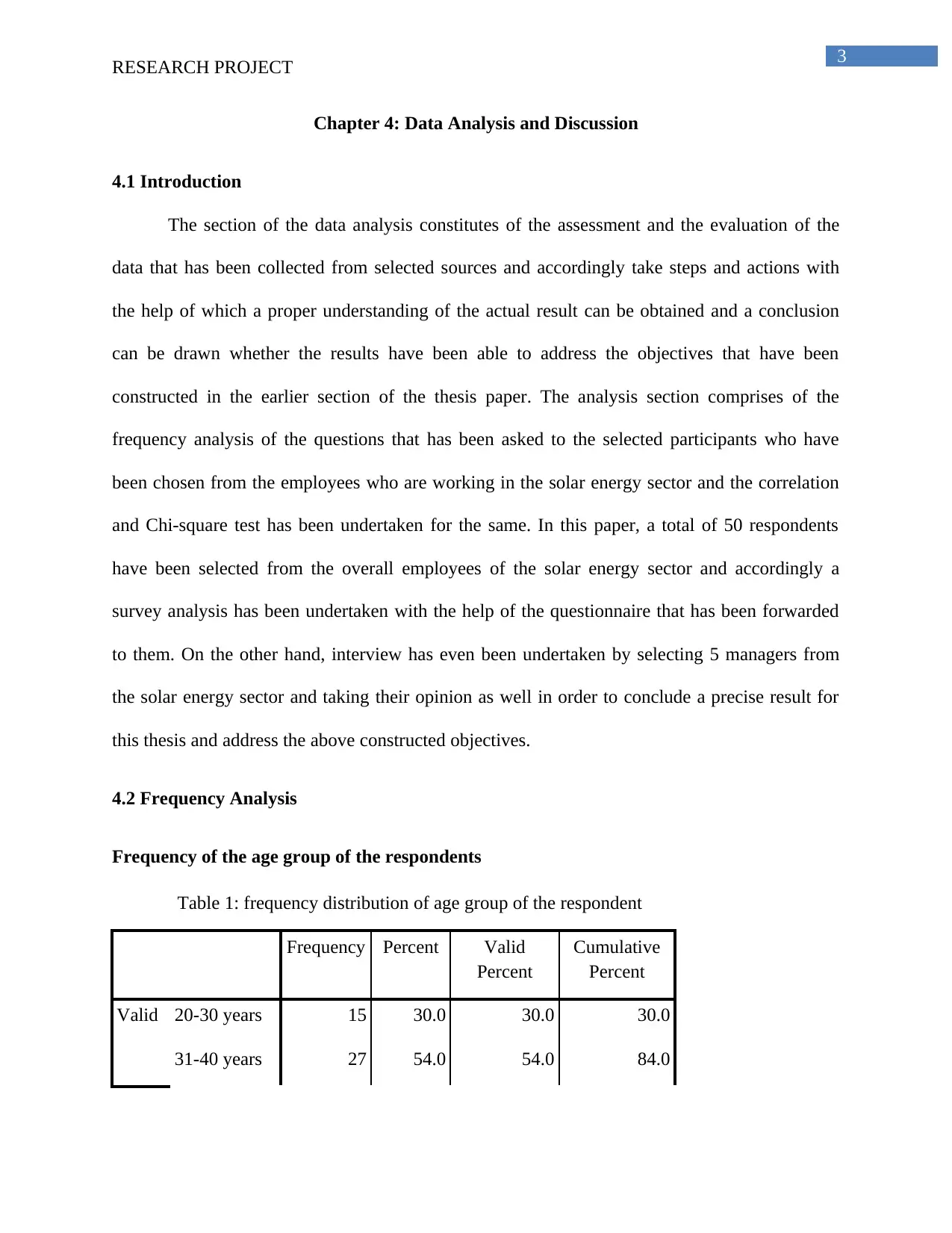
3
RESEARCH PROJECT
Chapter 4: Data Analysis and Discussion
4.1 Introduction
The section of the data analysis constitutes of the assessment and the evaluation of the
data that has been collected from selected sources and accordingly take steps and actions with
the help of which a proper understanding of the actual result can be obtained and a conclusion
can be drawn whether the results have been able to address the objectives that have been
constructed in the earlier section of the thesis paper. The analysis section comprises of the
frequency analysis of the questions that has been asked to the selected participants who have
been chosen from the employees who are working in the solar energy sector and the correlation
and Chi-square test has been undertaken for the same. In this paper, a total of 50 respondents
have been selected from the overall employees of the solar energy sector and accordingly a
survey analysis has been undertaken with the help of the questionnaire that has been forwarded
to them. On the other hand, interview has even been undertaken by selecting 5 managers from
the solar energy sector and taking their opinion as well in order to conclude a precise result for
this thesis and address the above constructed objectives.
4.2 Frequency Analysis
Frequency of the age group of the respondents
Table 1: frequency distribution of age group of the respondent
Frequency Percent Valid
Percent
Cumulative
Percent
Valid 20-30 years 15 30.0 30.0 30.0
31-40 years 27 54.0 54.0 84.0
RESEARCH PROJECT
Chapter 4: Data Analysis and Discussion
4.1 Introduction
The section of the data analysis constitutes of the assessment and the evaluation of the
data that has been collected from selected sources and accordingly take steps and actions with
the help of which a proper understanding of the actual result can be obtained and a conclusion
can be drawn whether the results have been able to address the objectives that have been
constructed in the earlier section of the thesis paper. The analysis section comprises of the
frequency analysis of the questions that has been asked to the selected participants who have
been chosen from the employees who are working in the solar energy sector and the correlation
and Chi-square test has been undertaken for the same. In this paper, a total of 50 respondents
have been selected from the overall employees of the solar energy sector and accordingly a
survey analysis has been undertaken with the help of the questionnaire that has been forwarded
to them. On the other hand, interview has even been undertaken by selecting 5 managers from
the solar energy sector and taking their opinion as well in order to conclude a precise result for
this thesis and address the above constructed objectives.
4.2 Frequency Analysis
Frequency of the age group of the respondents
Table 1: frequency distribution of age group of the respondent
Frequency Percent Valid
Percent
Cumulative
Percent
Valid 20-30 years 15 30.0 30.0 30.0
31-40 years 27 54.0 54.0 84.0
Secure Best Marks with AI Grader
Need help grading? Try our AI Grader for instant feedback on your assignments.

4
RESEARCH PROJECT
41 and above 8 16.0 16.0 100.0
Total 50 100.0 100.0
This question tries to discover the age group of the participants who have been chosen.
The results have disclosed the fact that 54% are within the age of 31-40 years, while 30% of
them are within the age of 20-30 years. The rest of 16% are within the age of 40 years and above.
The age of the respondents have indicated that most of the participants are middle aged and
therefore the solar energy sector has employees from diverse age groups.
Role in the company
Table 2 : frequency distribution of the respondents roles in the company
Frequency Percent Valid
Percent
Cumulative
Percent
Valid
Casual Worker 4 8.0 8.0 8.0
Entry level 14 28.0 28.0 36.0
Middle
management 27 54.0 54.0 90.0
Top management 5 10.0 10.0 100.0
Total 50 100.0 100.0
This question is related to gaining knowledge about the role or the position of the
participants in the company. The responses have shown that 54% of them are from the middle
management group and 28% are from the entry level. 10% of the selected candidates are from
RESEARCH PROJECT
41 and above 8 16.0 16.0 100.0
Total 50 100.0 100.0
This question tries to discover the age group of the participants who have been chosen.
The results have disclosed the fact that 54% are within the age of 31-40 years, while 30% of
them are within the age of 20-30 years. The rest of 16% are within the age of 40 years and above.
The age of the respondents have indicated that most of the participants are middle aged and
therefore the solar energy sector has employees from diverse age groups.
Role in the company
Table 2 : frequency distribution of the respondents roles in the company
Frequency Percent Valid
Percent
Cumulative
Percent
Valid
Casual Worker 4 8.0 8.0 8.0
Entry level 14 28.0 28.0 36.0
Middle
management 27 54.0 54.0 90.0
Top management 5 10.0 10.0 100.0
Total 50 100.0 100.0
This question is related to gaining knowledge about the role or the position of the
participants in the company. The responses have shown that 54% of them are from the middle
management group and 28% are from the entry level. 10% of the selected candidates are from
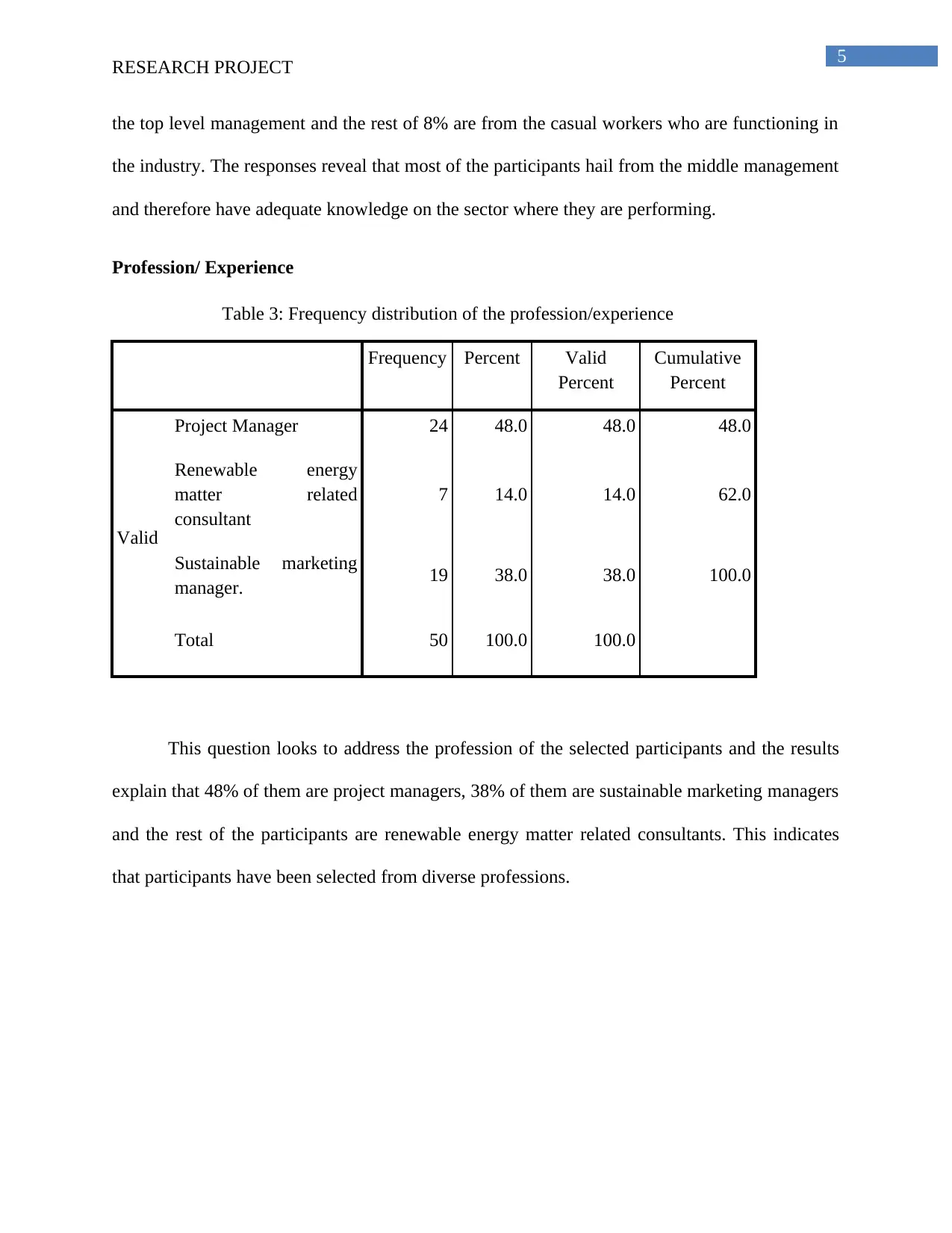
5
RESEARCH PROJECT
the top level management and the rest of 8% are from the casual workers who are functioning in
the industry. The responses reveal that most of the participants hail from the middle management
and therefore have adequate knowledge on the sector where they are performing.
Profession/ Experience
Table 3: Frequency distribution of the profession/experience
Frequency Percent Valid
Percent
Cumulative
Percent
Valid
Project Manager 24 48.0 48.0 48.0
Renewable energy
matter related
consultant
7 14.0 14.0 62.0
Sustainable marketing
manager. 19 38.0 38.0 100.0
Total 50 100.0 100.0
This question looks to address the profession of the selected participants and the results
explain that 48% of them are project managers, 38% of them are sustainable marketing managers
and the rest of the participants are renewable energy matter related consultants. This indicates
that participants have been selected from diverse professions.
RESEARCH PROJECT
the top level management and the rest of 8% are from the casual workers who are functioning in
the industry. The responses reveal that most of the participants hail from the middle management
and therefore have adequate knowledge on the sector where they are performing.
Profession/ Experience
Table 3: Frequency distribution of the profession/experience
Frequency Percent Valid
Percent
Cumulative
Percent
Valid
Project Manager 24 48.0 48.0 48.0
Renewable energy
matter related
consultant
7 14.0 14.0 62.0
Sustainable marketing
manager. 19 38.0 38.0 100.0
Total 50 100.0 100.0
This question looks to address the profession of the selected participants and the results
explain that 48% of them are project managers, 38% of them are sustainable marketing managers
and the rest of the participants are renewable energy matter related consultants. This indicates
that participants have been selected from diverse professions.
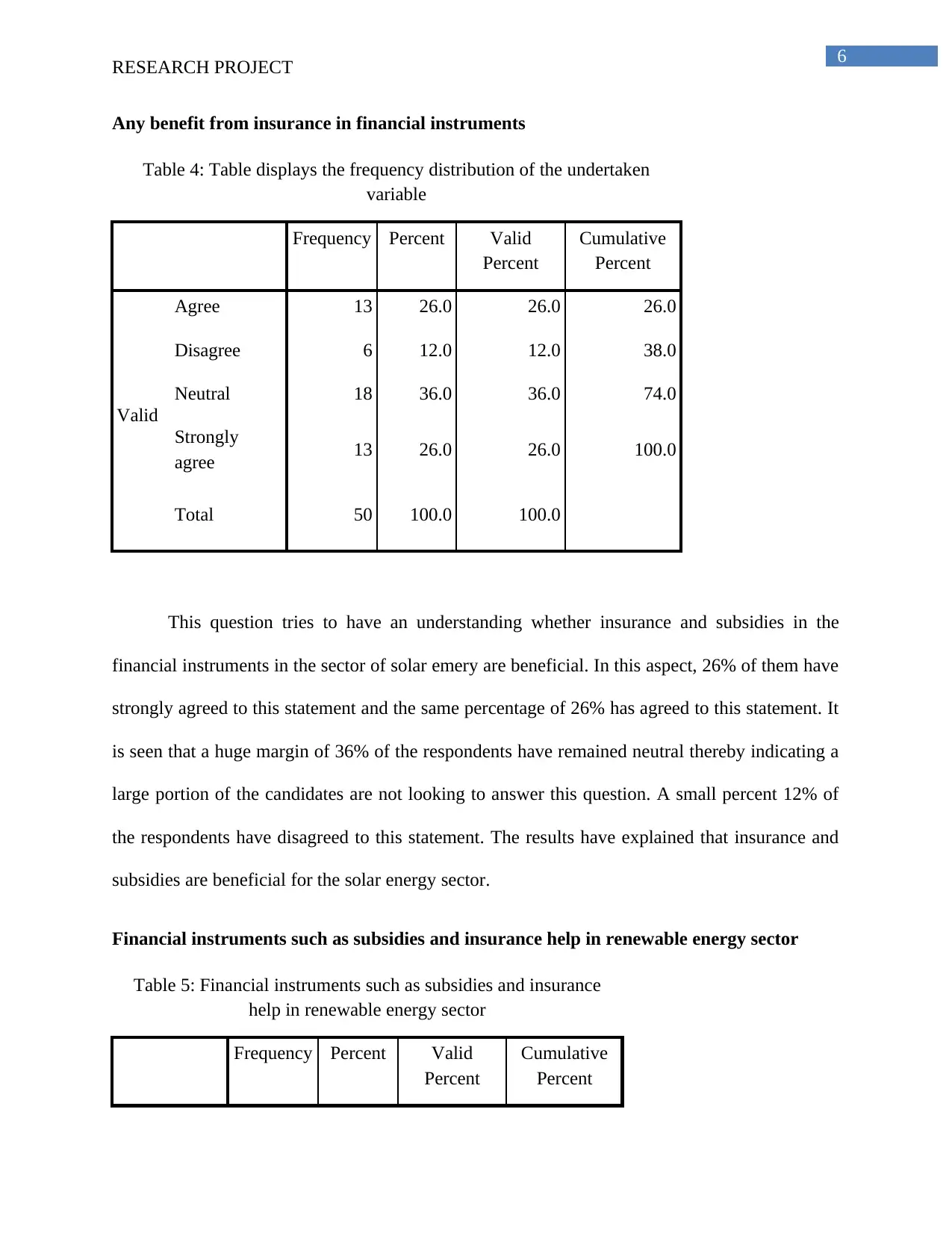
6
RESEARCH PROJECT
Any benefit from insurance in financial instruments
Table 4: Table displays the frequency distribution of the undertaken
variable
Frequency Percent Valid
Percent
Cumulative
Percent
Valid
Agree 13 26.0 26.0 26.0
Disagree 6 12.0 12.0 38.0
Neutral 18 36.0 36.0 74.0
Strongly
agree 13 26.0 26.0 100.0
Total 50 100.0 100.0
This question tries to have an understanding whether insurance and subsidies in the
financial instruments in the sector of solar emery are beneficial. In this aspect, 26% of them have
strongly agreed to this statement and the same percentage of 26% has agreed to this statement. It
is seen that a huge margin of 36% of the respondents have remained neutral thereby indicating a
large portion of the candidates are not looking to answer this question. A small percent 12% of
the respondents have disagreed to this statement. The results have explained that insurance and
subsidies are beneficial for the solar energy sector.
Financial instruments such as subsidies and insurance help in renewable energy sector
Table 5: Financial instruments such as subsidies and insurance
help in renewable energy sector
Frequency Percent Valid
Percent
Cumulative
Percent
RESEARCH PROJECT
Any benefit from insurance in financial instruments
Table 4: Table displays the frequency distribution of the undertaken
variable
Frequency Percent Valid
Percent
Cumulative
Percent
Valid
Agree 13 26.0 26.0 26.0
Disagree 6 12.0 12.0 38.0
Neutral 18 36.0 36.0 74.0
Strongly
agree 13 26.0 26.0 100.0
Total 50 100.0 100.0
This question tries to have an understanding whether insurance and subsidies in the
financial instruments in the sector of solar emery are beneficial. In this aspect, 26% of them have
strongly agreed to this statement and the same percentage of 26% has agreed to this statement. It
is seen that a huge margin of 36% of the respondents have remained neutral thereby indicating a
large portion of the candidates are not looking to answer this question. A small percent 12% of
the respondents have disagreed to this statement. The results have explained that insurance and
subsidies are beneficial for the solar energy sector.
Financial instruments such as subsidies and insurance help in renewable energy sector
Table 5: Financial instruments such as subsidies and insurance
help in renewable energy sector
Frequency Percent Valid
Percent
Cumulative
Percent
Paraphrase This Document
Need a fresh take? Get an instant paraphrase of this document with our AI Paraphraser
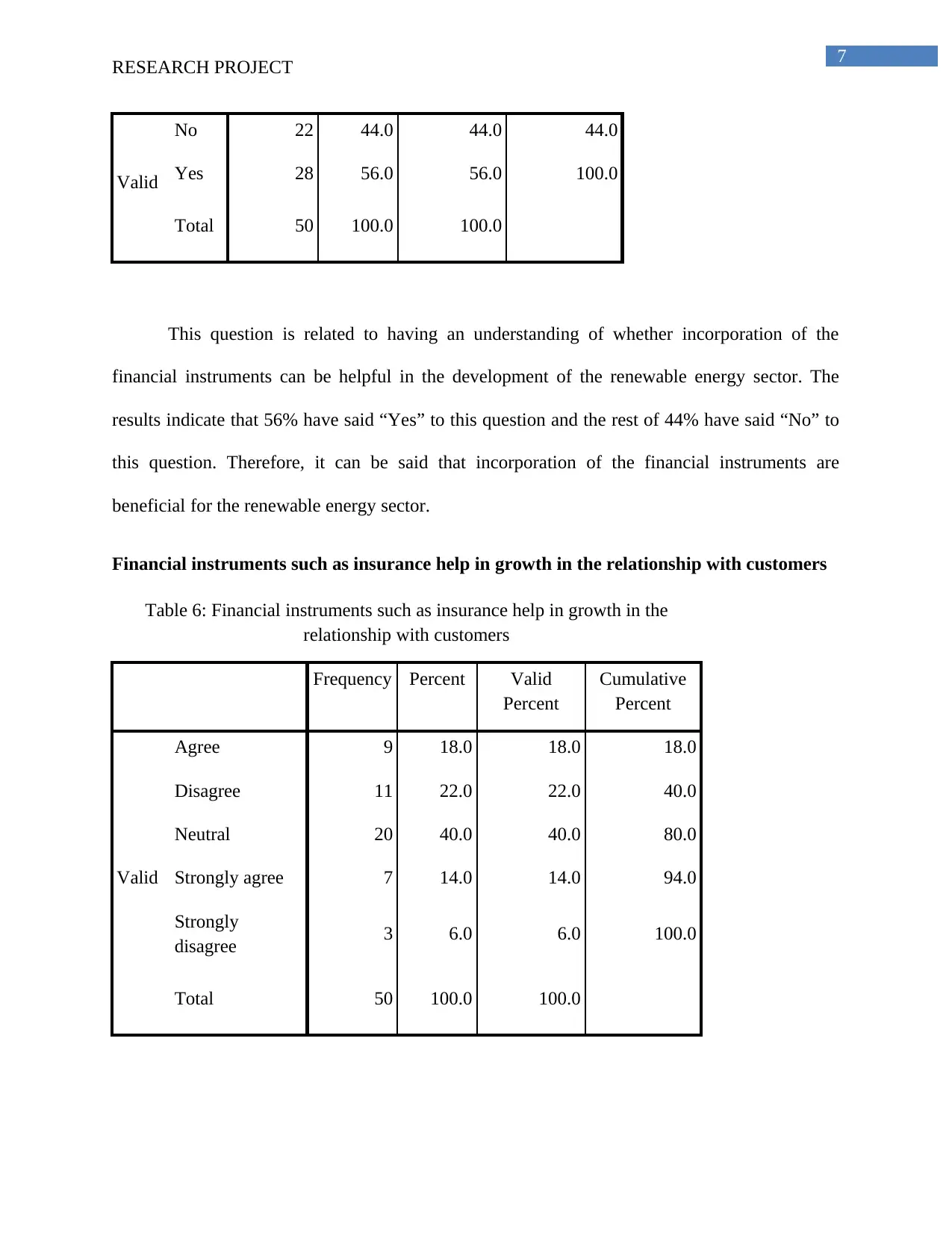
7
RESEARCH PROJECT
Valid
No 22 44.0 44.0 44.0
Yes 28 56.0 56.0 100.0
Total 50 100.0 100.0
This question is related to having an understanding of whether incorporation of the
financial instruments can be helpful in the development of the renewable energy sector. The
results indicate that 56% have said “Yes” to this question and the rest of 44% have said “No” to
this question. Therefore, it can be said that incorporation of the financial instruments are
beneficial for the renewable energy sector.
Financial instruments such as insurance help in growth in the relationship with customers
Table 6: Financial instruments such as insurance help in growth in the
relationship with customers
Frequency Percent Valid
Percent
Cumulative
Percent
Valid
Agree 9 18.0 18.0 18.0
Disagree 11 22.0 22.0 40.0
Neutral 20 40.0 40.0 80.0
Strongly agree 7 14.0 14.0 94.0
Strongly
disagree 3 6.0 6.0 100.0
Total 50 100.0 100.0
RESEARCH PROJECT
Valid
No 22 44.0 44.0 44.0
Yes 28 56.0 56.0 100.0
Total 50 100.0 100.0
This question is related to having an understanding of whether incorporation of the
financial instruments can be helpful in the development of the renewable energy sector. The
results indicate that 56% have said “Yes” to this question and the rest of 44% have said “No” to
this question. Therefore, it can be said that incorporation of the financial instruments are
beneficial for the renewable energy sector.
Financial instruments such as insurance help in growth in the relationship with customers
Table 6: Financial instruments such as insurance help in growth in the
relationship with customers
Frequency Percent Valid
Percent
Cumulative
Percent
Valid
Agree 9 18.0 18.0 18.0
Disagree 11 22.0 22.0 40.0
Neutral 20 40.0 40.0 80.0
Strongly agree 7 14.0 14.0 94.0
Strongly
disagree 3 6.0 6.0 100.0
Total 50 100.0 100.0
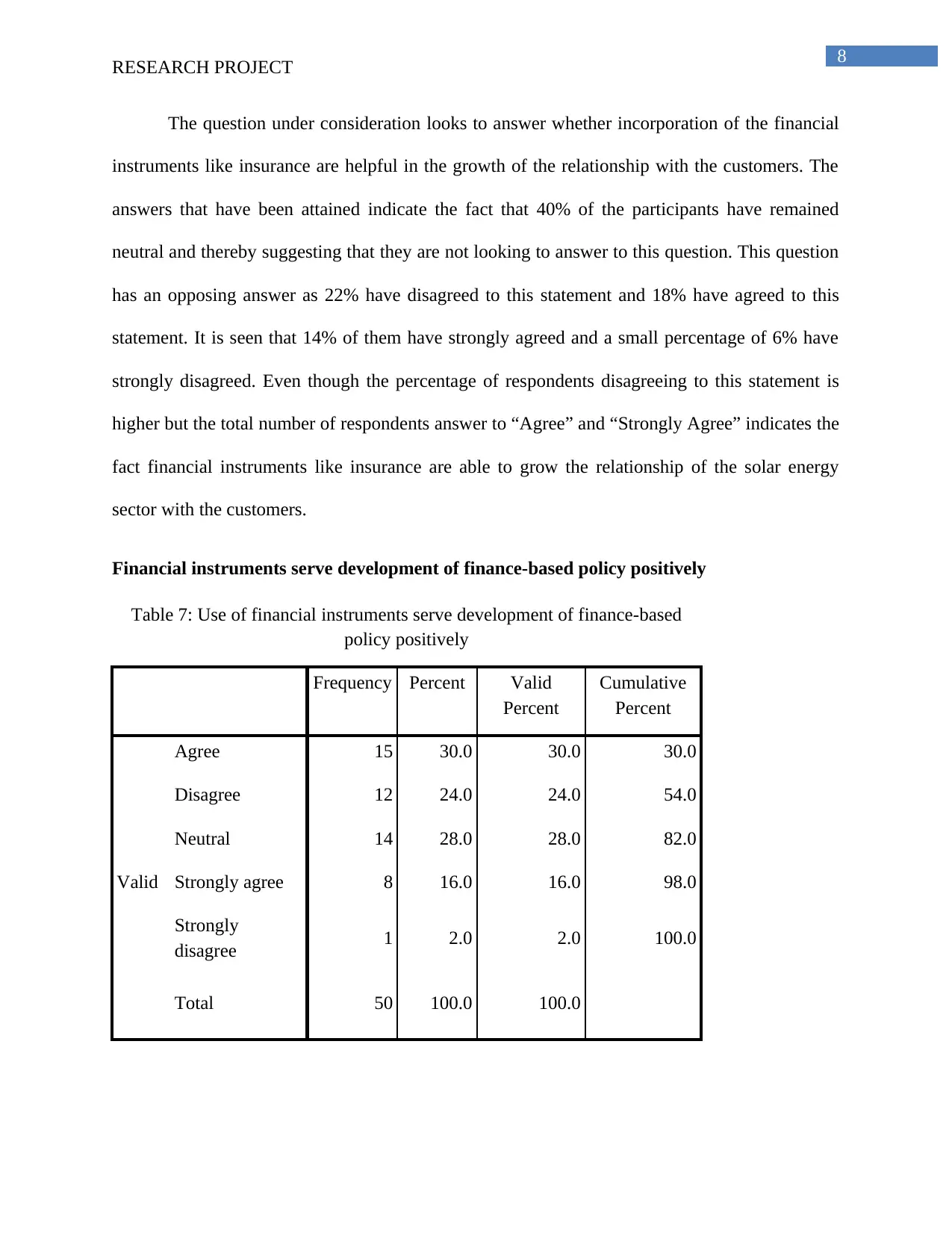
8
RESEARCH PROJECT
The question under consideration looks to answer whether incorporation of the financial
instruments like insurance are helpful in the growth of the relationship with the customers. The
answers that have been attained indicate the fact that 40% of the participants have remained
neutral and thereby suggesting that they are not looking to answer to this question. This question
has an opposing answer as 22% have disagreed to this statement and 18% have agreed to this
statement. It is seen that 14% of them have strongly agreed and a small percentage of 6% have
strongly disagreed. Even though the percentage of respondents disagreeing to this statement is
higher but the total number of respondents answer to “Agree” and “Strongly Agree” indicates the
fact financial instruments like insurance are able to grow the relationship of the solar energy
sector with the customers.
Financial instruments serve development of finance-based policy positively
Table 7: Use of financial instruments serve development of finance-based
policy positively
Frequency Percent Valid
Percent
Cumulative
Percent
Valid
Agree 15 30.0 30.0 30.0
Disagree 12 24.0 24.0 54.0
Neutral 14 28.0 28.0 82.0
Strongly agree 8 16.0 16.0 98.0
Strongly
disagree 1 2.0 2.0 100.0
Total 50 100.0 100.0
RESEARCH PROJECT
The question under consideration looks to answer whether incorporation of the financial
instruments like insurance are helpful in the growth of the relationship with the customers. The
answers that have been attained indicate the fact that 40% of the participants have remained
neutral and thereby suggesting that they are not looking to answer to this question. This question
has an opposing answer as 22% have disagreed to this statement and 18% have agreed to this
statement. It is seen that 14% of them have strongly agreed and a small percentage of 6% have
strongly disagreed. Even though the percentage of respondents disagreeing to this statement is
higher but the total number of respondents answer to “Agree” and “Strongly Agree” indicates the
fact financial instruments like insurance are able to grow the relationship of the solar energy
sector with the customers.
Financial instruments serve development of finance-based policy positively
Table 7: Use of financial instruments serve development of finance-based
policy positively
Frequency Percent Valid
Percent
Cumulative
Percent
Valid
Agree 15 30.0 30.0 30.0
Disagree 12 24.0 24.0 54.0
Neutral 14 28.0 28.0 82.0
Strongly agree 8 16.0 16.0 98.0
Strongly
disagree 1 2.0 2.0 100.0
Total 50 100.0 100.0
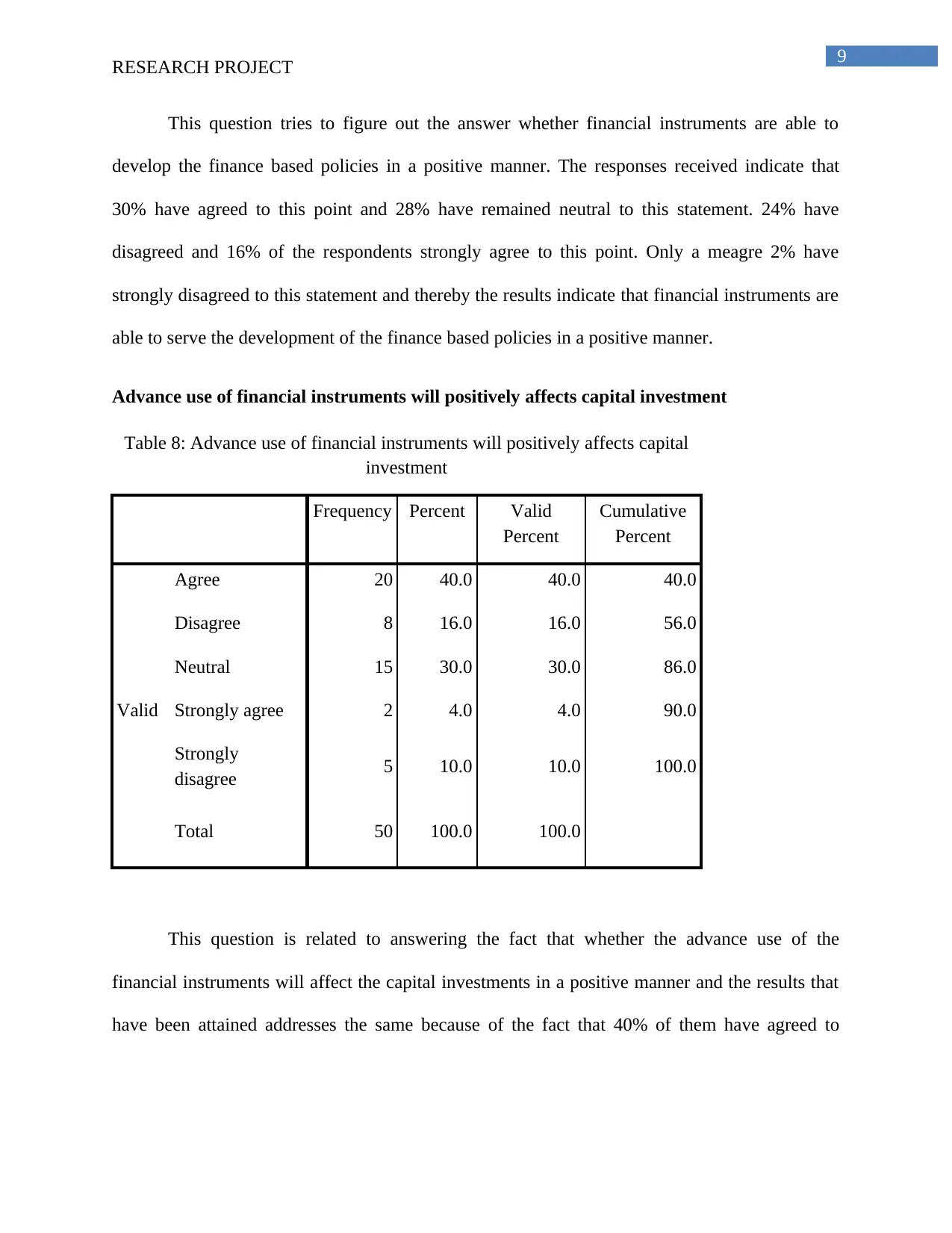
9
RESEARCH PROJECT
This question tries to figure out the answer whether financial instruments are able to
develop the finance based policies in a positive manner. The responses received indicate that
30% have agreed to this point and 28% have remained neutral to this statement. 24% have
disagreed and 16% of the respondents strongly agree to this point. Only a meagre 2% have
strongly disagreed to this statement and thereby the results indicate that financial instruments are
able to serve the development of the finance based policies in a positive manner.
Advance use of financial instruments will positively affects capital investment
Table 8: Advance use of financial instruments will positively affects capital
investment
Frequency Percent Valid
Percent
Cumulative
Percent
Valid
Agree 20 40.0 40.0 40.0
Disagree 8 16.0 16.0 56.0
Neutral 15 30.0 30.0 86.0
Strongly agree 2 4.0 4.0 90.0
Strongly
disagree 5 10.0 10.0 100.0
Total 50 100.0 100.0
This question is related to answering the fact that whether the advance use of the
financial instruments will affect the capital investments in a positive manner and the results that
have been attained addresses the same because of the fact that 40% of them have agreed to
RESEARCH PROJECT
This question tries to figure out the answer whether financial instruments are able to
develop the finance based policies in a positive manner. The responses received indicate that
30% have agreed to this point and 28% have remained neutral to this statement. 24% have
disagreed and 16% of the respondents strongly agree to this point. Only a meagre 2% have
strongly disagreed to this statement and thereby the results indicate that financial instruments are
able to serve the development of the finance based policies in a positive manner.
Advance use of financial instruments will positively affects capital investment
Table 8: Advance use of financial instruments will positively affects capital
investment
Frequency Percent Valid
Percent
Cumulative
Percent
Valid
Agree 20 40.0 40.0 40.0
Disagree 8 16.0 16.0 56.0
Neutral 15 30.0 30.0 86.0
Strongly agree 2 4.0 4.0 90.0
Strongly
disagree 5 10.0 10.0 100.0
Total 50 100.0 100.0
This question is related to answering the fact that whether the advance use of the
financial instruments will affect the capital investments in a positive manner and the results that
have been attained addresses the same because of the fact that 40% of them have agreed to
Secure Best Marks with AI Grader
Need help grading? Try our AI Grader for instant feedback on your assignments.
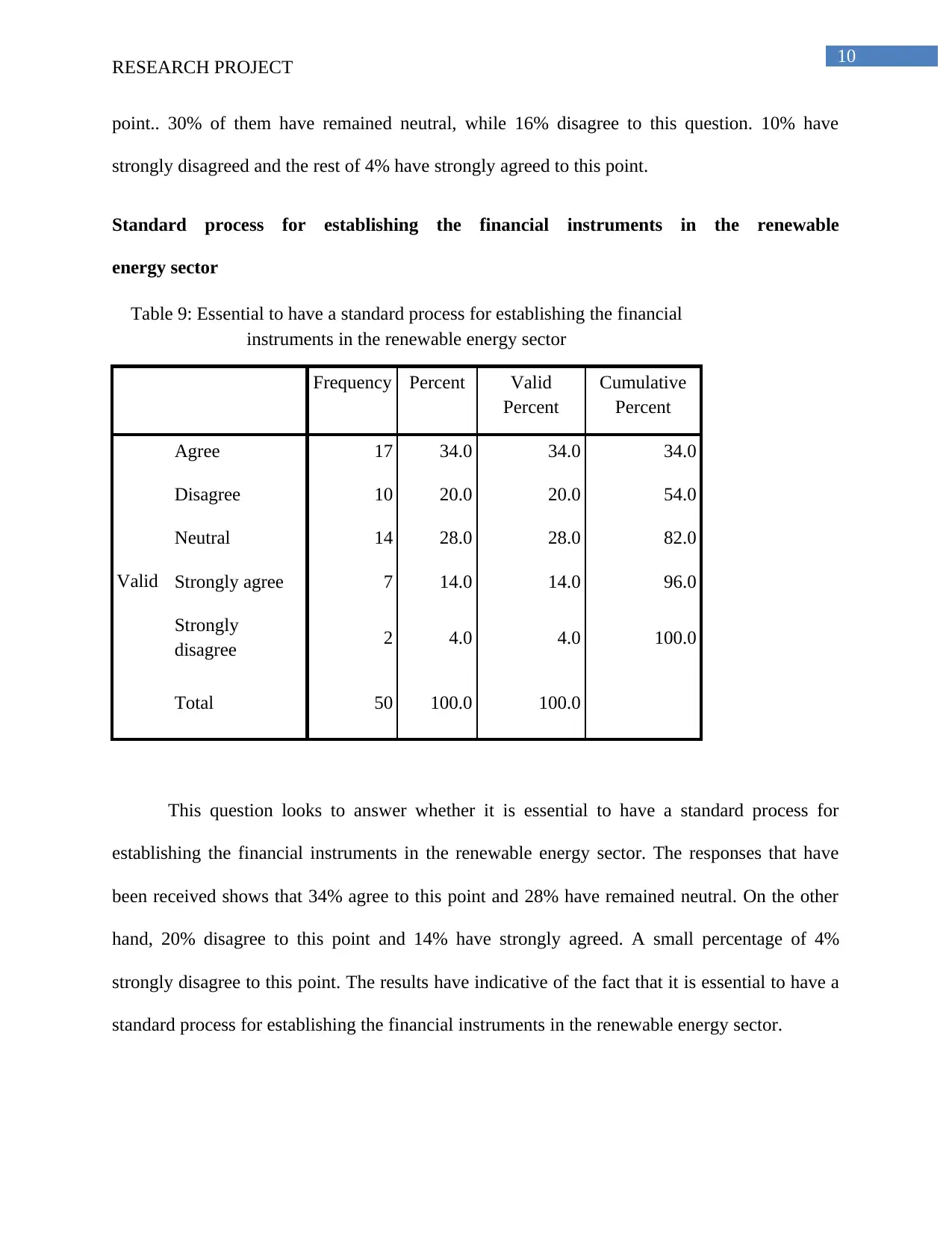
10
RESEARCH PROJECT
point.. 30% of them have remained neutral, while 16% disagree to this question. 10% have
strongly disagreed and the rest of 4% have strongly agreed to this point.
Standard process for establishing the financial instruments in the renewable
energy sector
Table 9: Essential to have a standard process for establishing the financial
instruments in the renewable energy sector
Frequency Percent Valid
Percent
Cumulative
Percent
Valid
Agree 17 34.0 34.0 34.0
Disagree 10 20.0 20.0 54.0
Neutral 14 28.0 28.0 82.0
Strongly agree 7 14.0 14.0 96.0
Strongly
disagree 2 4.0 4.0 100.0
Total 50 100.0 100.0
This question looks to answer whether it is essential to have a standard process for
establishing the financial instruments in the renewable energy sector. The responses that have
been received shows that 34% agree to this point and 28% have remained neutral. On the other
hand, 20% disagree to this point and 14% have strongly agreed. A small percentage of 4%
strongly disagree to this point. The results have indicative of the fact that it is essential to have a
standard process for establishing the financial instruments in the renewable energy sector.
RESEARCH PROJECT
point.. 30% of them have remained neutral, while 16% disagree to this question. 10% have
strongly disagreed and the rest of 4% have strongly agreed to this point.
Standard process for establishing the financial instruments in the renewable
energy sector
Table 9: Essential to have a standard process for establishing the financial
instruments in the renewable energy sector
Frequency Percent Valid
Percent
Cumulative
Percent
Valid
Agree 17 34.0 34.0 34.0
Disagree 10 20.0 20.0 54.0
Neutral 14 28.0 28.0 82.0
Strongly agree 7 14.0 14.0 96.0
Strongly
disagree 2 4.0 4.0 100.0
Total 50 100.0 100.0
This question looks to answer whether it is essential to have a standard process for
establishing the financial instruments in the renewable energy sector. The responses that have
been received shows that 34% agree to this point and 28% have remained neutral. On the other
hand, 20% disagree to this point and 14% have strongly agreed. A small percentage of 4%
strongly disagree to this point. The results have indicative of the fact that it is essential to have a
standard process for establishing the financial instruments in the renewable energy sector.
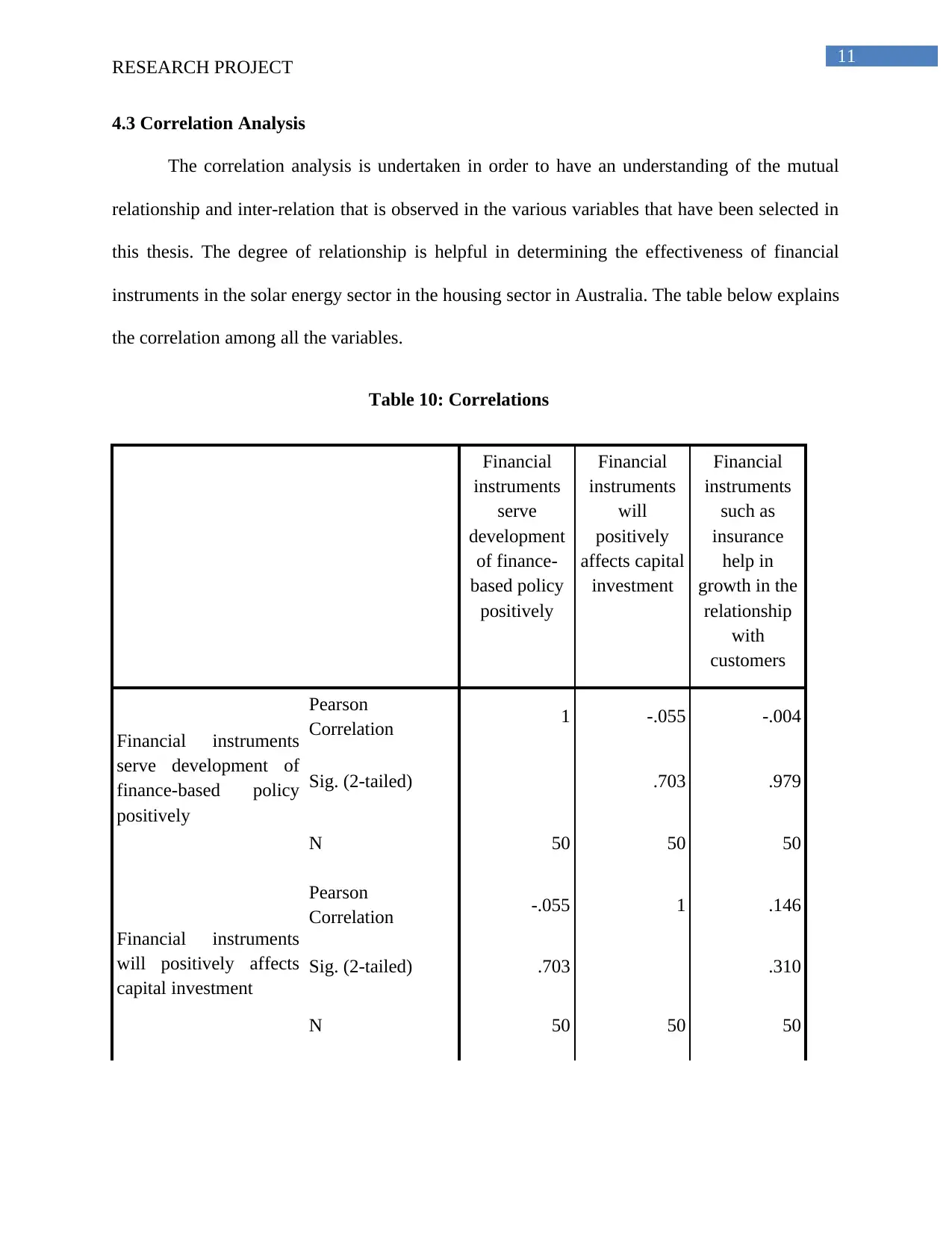
11
RESEARCH PROJECT
4.3 Correlation Analysis
The correlation analysis is undertaken in order to have an understanding of the mutual
relationship and inter-relation that is observed in the various variables that have been selected in
this thesis. The degree of relationship is helpful in determining the effectiveness of financial
instruments in the solar energy sector in the housing sector in Australia. The table below explains
the correlation among all the variables.
Table 10: Correlations
Financial
instruments
serve
development
of finance-
based policy
positively
Financial
instruments
will
positively
affects capital
investment
Financial
instruments
such as
insurance
help in
growth in the
relationship
with
customers
Financial instruments
serve development of
finance-based policy
positively
Pearson
Correlation 1 -.055 -.004
Sig. (2-tailed) .703 .979
N 50 50 50
Financial instruments
will positively affects
capital investment
Pearson
Correlation -.055 1 .146
Sig. (2-tailed) .703 .310
N 50 50 50
RESEARCH PROJECT
4.3 Correlation Analysis
The correlation analysis is undertaken in order to have an understanding of the mutual
relationship and inter-relation that is observed in the various variables that have been selected in
this thesis. The degree of relationship is helpful in determining the effectiveness of financial
instruments in the solar energy sector in the housing sector in Australia. The table below explains
the correlation among all the variables.
Table 10: Correlations
Financial
instruments
serve
development
of finance-
based policy
positively
Financial
instruments
will
positively
affects capital
investment
Financial
instruments
such as
insurance
help in
growth in the
relationship
with
customers
Financial instruments
serve development of
finance-based policy
positively
Pearson
Correlation 1 -.055 -.004
Sig. (2-tailed) .703 .979
N 50 50 50
Financial instruments
will positively affects
capital investment
Pearson
Correlation -.055 1 .146
Sig. (2-tailed) .703 .310
N 50 50 50
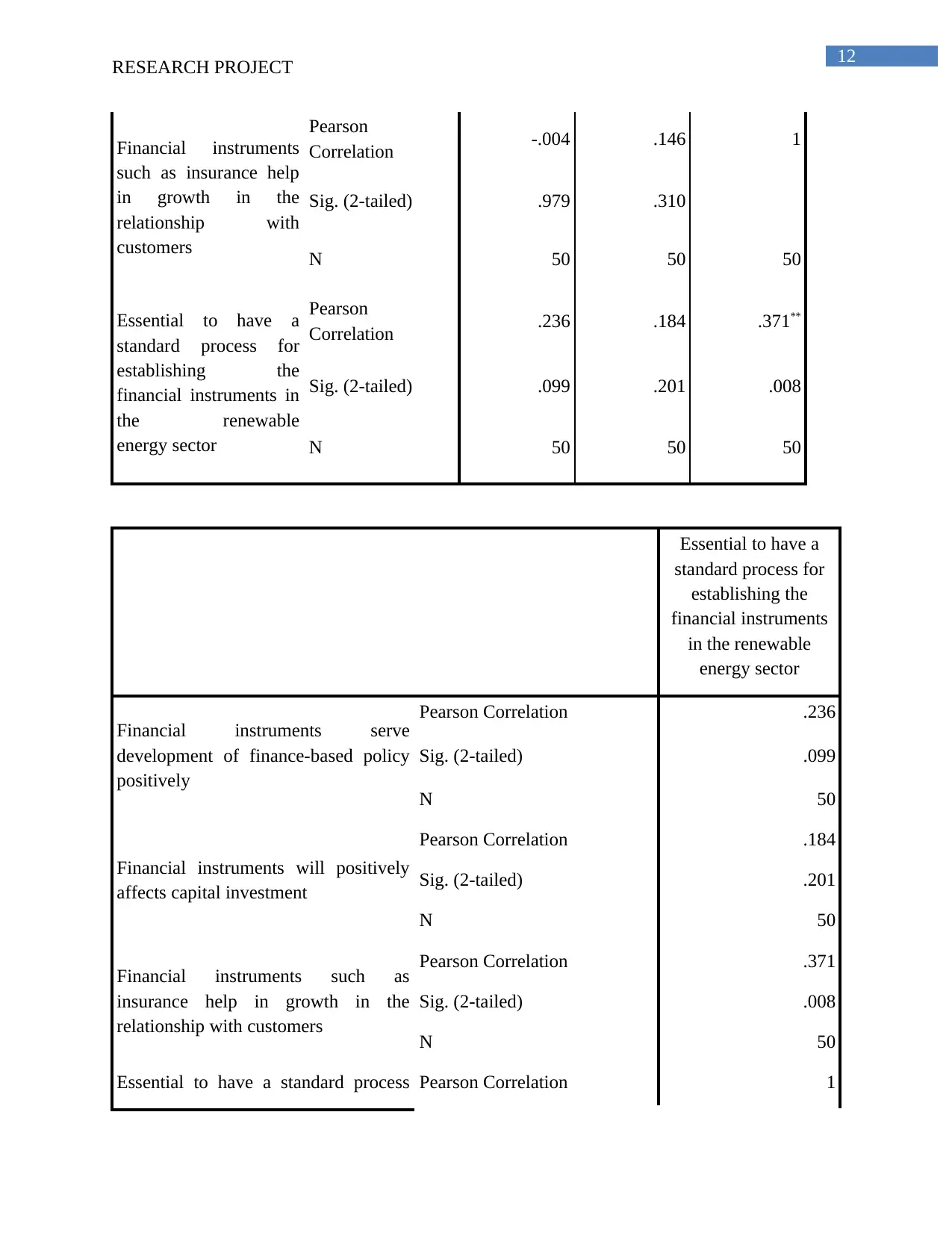
12
RESEARCH PROJECT
Financial instruments
such as insurance help
in growth in the
relationship with
customers
Pearson
Correlation -.004 .146 1
Sig. (2-tailed) .979 .310
N 50 50 50
Essential to have a
standard process for
establishing the
financial instruments in
the renewable
energy sector
Pearson
Correlation .236 .184 .371**
Sig. (2-tailed) .099 .201 .008
N 50 50 50
Essential to have a
standard process for
establishing the
financial instruments
in the renewable
energy sector
Financial instruments serve
development of finance-based policy
positively
Pearson Correlation .236
Sig. (2-tailed) .099
N 50
Financial instruments will positively
affects capital investment
Pearson Correlation .184
Sig. (2-tailed) .201
N 50
Financial instruments such as
insurance help in growth in the
relationship with customers
Pearson Correlation .371
Sig. (2-tailed) .008
N 50
Essential to have a standard process Pearson Correlation 1
RESEARCH PROJECT
Financial instruments
such as insurance help
in growth in the
relationship with
customers
Pearson
Correlation -.004 .146 1
Sig. (2-tailed) .979 .310
N 50 50 50
Essential to have a
standard process for
establishing the
financial instruments in
the renewable
energy sector
Pearson
Correlation .236 .184 .371**
Sig. (2-tailed) .099 .201 .008
N 50 50 50
Essential to have a
standard process for
establishing the
financial instruments
in the renewable
energy sector
Financial instruments serve
development of finance-based policy
positively
Pearson Correlation .236
Sig. (2-tailed) .099
N 50
Financial instruments will positively
affects capital investment
Pearson Correlation .184
Sig. (2-tailed) .201
N 50
Financial instruments such as
insurance help in growth in the
relationship with customers
Pearson Correlation .371
Sig. (2-tailed) .008
N 50
Essential to have a standard process Pearson Correlation 1
Paraphrase This Document
Need a fresh take? Get an instant paraphrase of this document with our AI Paraphraser
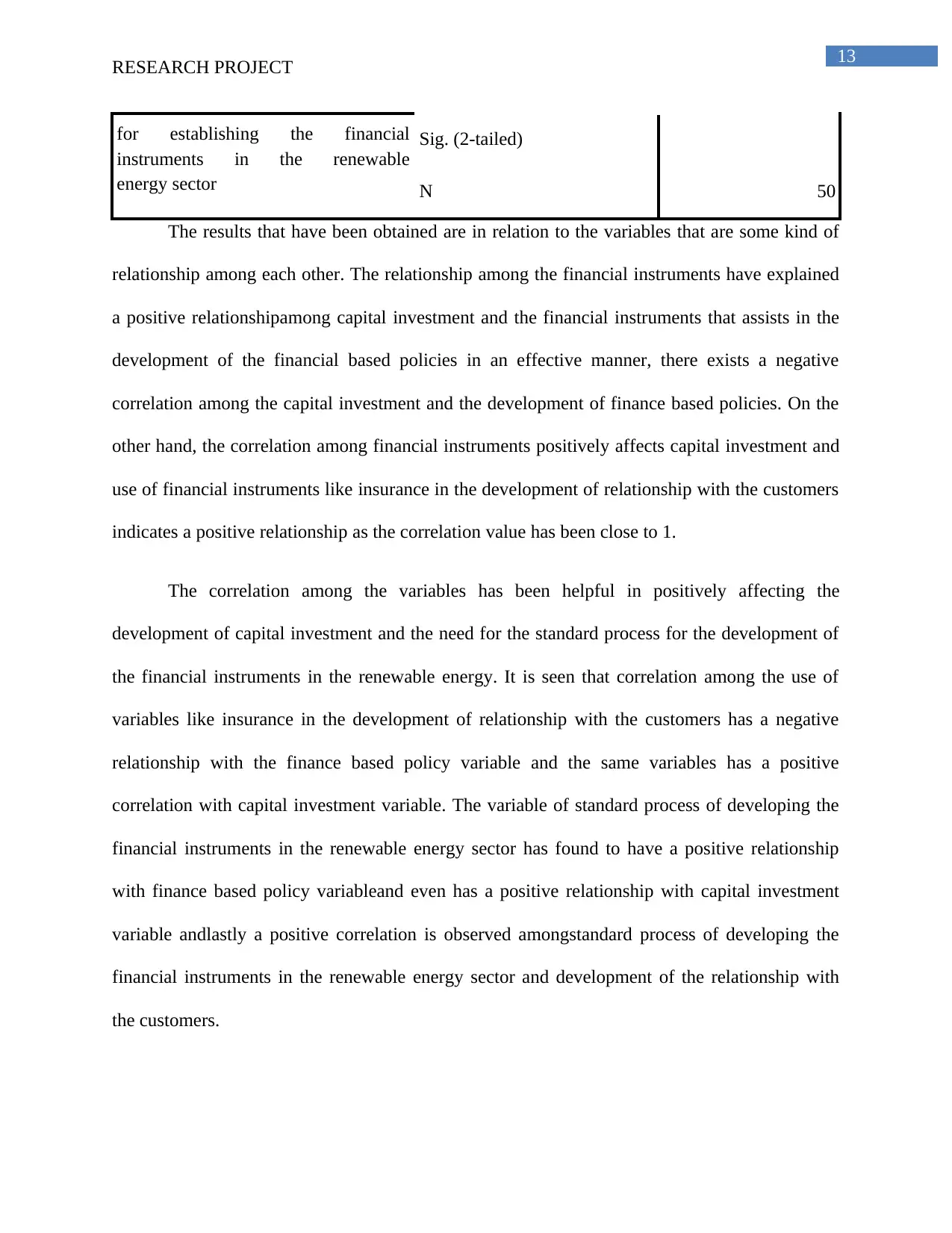
13
RESEARCH PROJECT
for establishing the financial
instruments in the renewable
energy sector
Sig. (2-tailed)
N 50
The results that have been obtained are in relation to the variables that are some kind of
relationship among each other. The relationship among the financial instruments have explained
a positive relationshipamong capital investment and the financial instruments that assists in the
development of the financial based policies in an effective manner, there exists a negative
correlation among the capital investment and the development of finance based policies. On the
other hand, the correlation among financial instruments positively affects capital investment and
use of financial instruments like insurance in the development of relationship with the customers
indicates a positive relationship as the correlation value has been close to 1.
The correlation among the variables has been helpful in positively affecting the
development of capital investment and the need for the standard process for the development of
the financial instruments in the renewable energy. It is seen that correlation among the use of
variables like insurance in the development of relationship with the customers has a negative
relationship with the finance based policy variable and the same variables has a positive
correlation with capital investment variable. The variable of standard process of developing the
financial instruments in the renewable energy sector has found to have a positive relationship
with finance based policy variableand even has a positive relationship with capital investment
variable andlastly a positive correlation is observed amongstandard process of developing the
financial instruments in the renewable energy sector and development of the relationship with
the customers.
RESEARCH PROJECT
for establishing the financial
instruments in the renewable
energy sector
Sig. (2-tailed)
N 50
The results that have been obtained are in relation to the variables that are some kind of
relationship among each other. The relationship among the financial instruments have explained
a positive relationshipamong capital investment and the financial instruments that assists in the
development of the financial based policies in an effective manner, there exists a negative
correlation among the capital investment and the development of finance based policies. On the
other hand, the correlation among financial instruments positively affects capital investment and
use of financial instruments like insurance in the development of relationship with the customers
indicates a positive relationship as the correlation value has been close to 1.
The correlation among the variables has been helpful in positively affecting the
development of capital investment and the need for the standard process for the development of
the financial instruments in the renewable energy. It is seen that correlation among the use of
variables like insurance in the development of relationship with the customers has a negative
relationship with the finance based policy variable and the same variables has a positive
correlation with capital investment variable. The variable of standard process of developing the
financial instruments in the renewable energy sector has found to have a positive relationship
with finance based policy variableand even has a positive relationship with capital investment
variable andlastly a positive correlation is observed amongstandard process of developing the
financial instruments in the renewable energy sector and development of the relationship with
the customers.
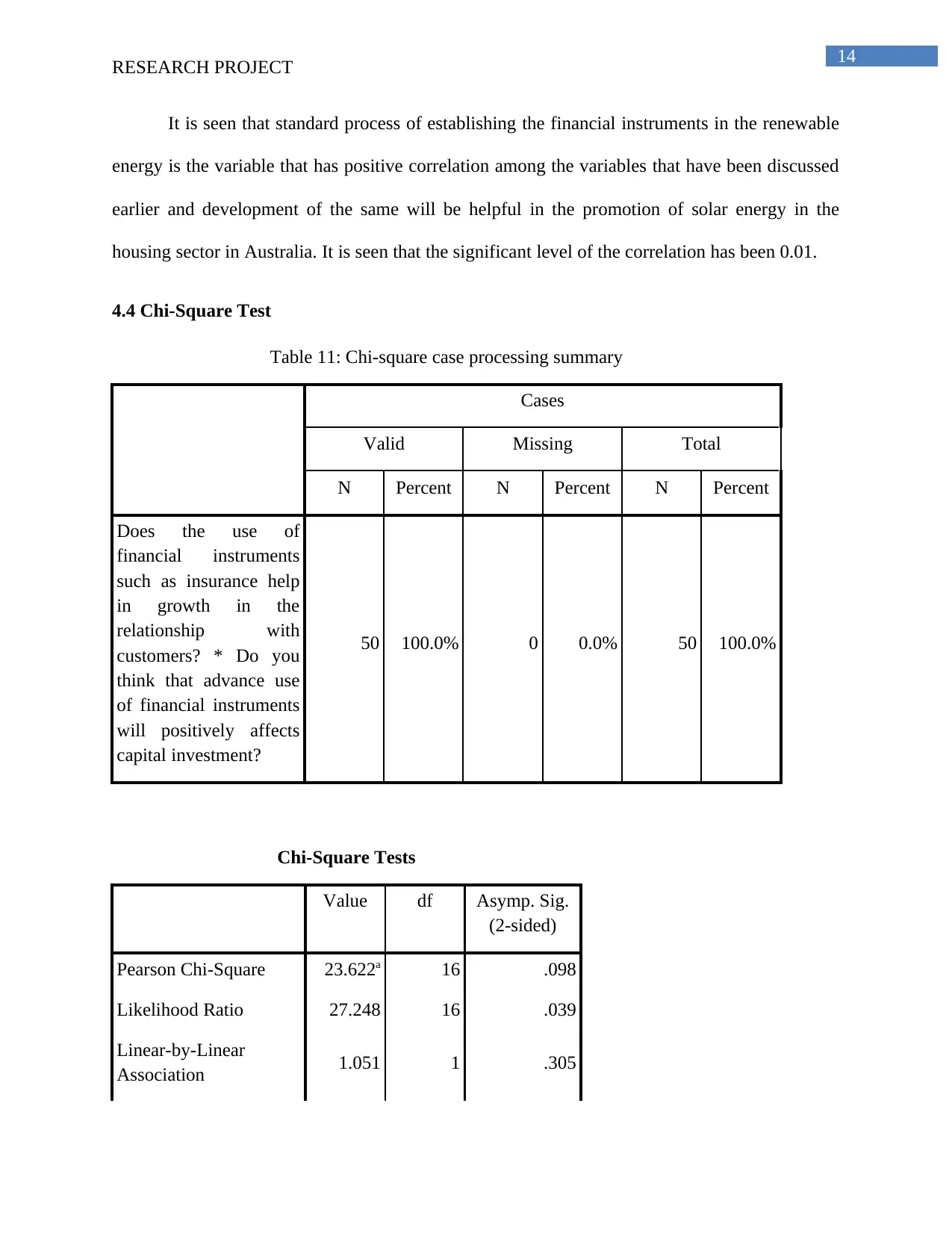
14
RESEARCH PROJECT
It is seen that standard process of establishing the financial instruments in the renewable
energy is the variable that has positive correlation among the variables that have been discussed
earlier and development of the same will be helpful in the promotion of solar energy in the
housing sector in Australia. It is seen that the significant level of the correlation has been 0.01.
4.4 Chi-Square Test
Table 11: Chi-square case processing summary
Cases
Valid Missing Total
N Percent N Percent N Percent
Does the use of
financial instruments
such as insurance help
in growth in the
relationship with
customers? * Do you
think that advance use
of financial instruments
will positively affects
capital investment?
50 100.0% 0 0.0% 50 100.0%
Chi-Square Tests
Value df Asymp. Sig.
(2-sided)
Pearson Chi-Square 23.622a 16 .098
Likelihood Ratio 27.248 16 .039
Linear-by-Linear
Association 1.051 1 .305
RESEARCH PROJECT
It is seen that standard process of establishing the financial instruments in the renewable
energy is the variable that has positive correlation among the variables that have been discussed
earlier and development of the same will be helpful in the promotion of solar energy in the
housing sector in Australia. It is seen that the significant level of the correlation has been 0.01.
4.4 Chi-Square Test
Table 11: Chi-square case processing summary
Cases
Valid Missing Total
N Percent N Percent N Percent
Does the use of
financial instruments
such as insurance help
in growth in the
relationship with
customers? * Do you
think that advance use
of financial instruments
will positively affects
capital investment?
50 100.0% 0 0.0% 50 100.0%
Chi-Square Tests
Value df Asymp. Sig.
(2-sided)
Pearson Chi-Square 23.622a 16 .098
Likelihood Ratio 27.248 16 .039
Linear-by-Linear
Association 1.051 1 .305
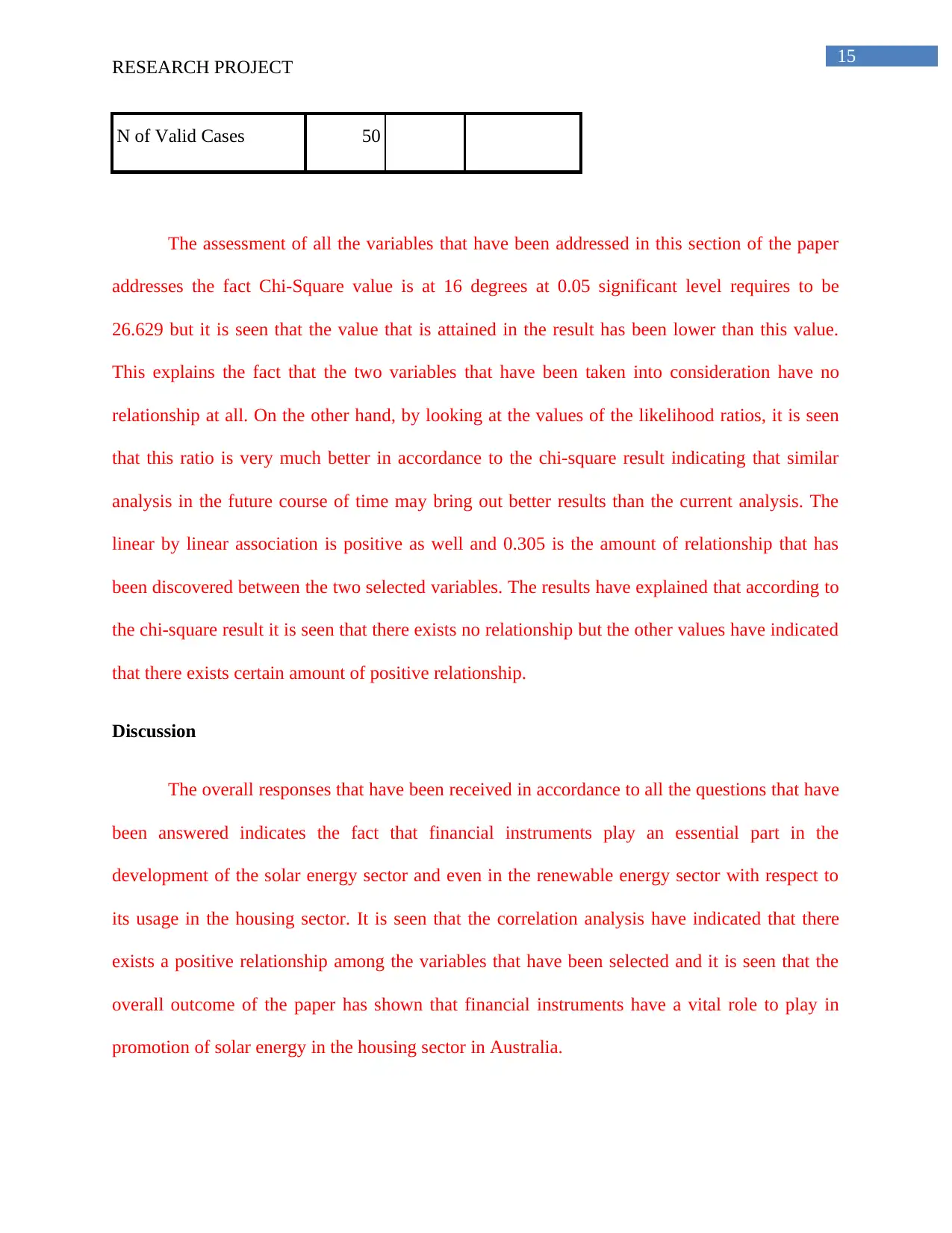
15
RESEARCH PROJECT
N of Valid Cases 50
The assessment of all the variables that have been addressed in this section of the paper
addresses the fact Chi-Square value is at 16 degrees at 0.05 significant level requires to be
26.629 but it is seen that the value that is attained in the result has been lower than this value.
This explains the fact that the two variables that have been taken into consideration have no
relationship at all. On the other hand, by looking at the values of the likelihood ratios, it is seen
that this ratio is very much better in accordance to the chi-square result indicating that similar
analysis in the future course of time may bring out better results than the current analysis. The
linear by linear association is positive as well and 0.305 is the amount of relationship that has
been discovered between the two selected variables. The results have explained that according to
the chi-square result it is seen that there exists no relationship but the other values have indicated
that there exists certain amount of positive relationship.
Discussion
The overall responses that have been received in accordance to all the questions that have
been answered indicates the fact that financial instruments play an essential part in the
development of the solar energy sector and even in the renewable energy sector with respect to
its usage in the housing sector. It is seen that the correlation analysis have indicated that there
exists a positive relationship among the variables that have been selected and it is seen that the
overall outcome of the paper has shown that financial instruments have a vital role to play in
promotion of solar energy in the housing sector in Australia.
RESEARCH PROJECT
N of Valid Cases 50
The assessment of all the variables that have been addressed in this section of the paper
addresses the fact Chi-Square value is at 16 degrees at 0.05 significant level requires to be
26.629 but it is seen that the value that is attained in the result has been lower than this value.
This explains the fact that the two variables that have been taken into consideration have no
relationship at all. On the other hand, by looking at the values of the likelihood ratios, it is seen
that this ratio is very much better in accordance to the chi-square result indicating that similar
analysis in the future course of time may bring out better results than the current analysis. The
linear by linear association is positive as well and 0.305 is the amount of relationship that has
been discovered between the two selected variables. The results have explained that according to
the chi-square result it is seen that there exists no relationship but the other values have indicated
that there exists certain amount of positive relationship.
Discussion
The overall responses that have been received in accordance to all the questions that have
been answered indicates the fact that financial instruments play an essential part in the
development of the solar energy sector and even in the renewable energy sector with respect to
its usage in the housing sector. It is seen that the correlation analysis have indicated that there
exists a positive relationship among the variables that have been selected and it is seen that the
overall outcome of the paper has shown that financial instruments have a vital role to play in
promotion of solar energy in the housing sector in Australia.
Secure Best Marks with AI Grader
Need help grading? Try our AI Grader for instant feedback on your assignments.
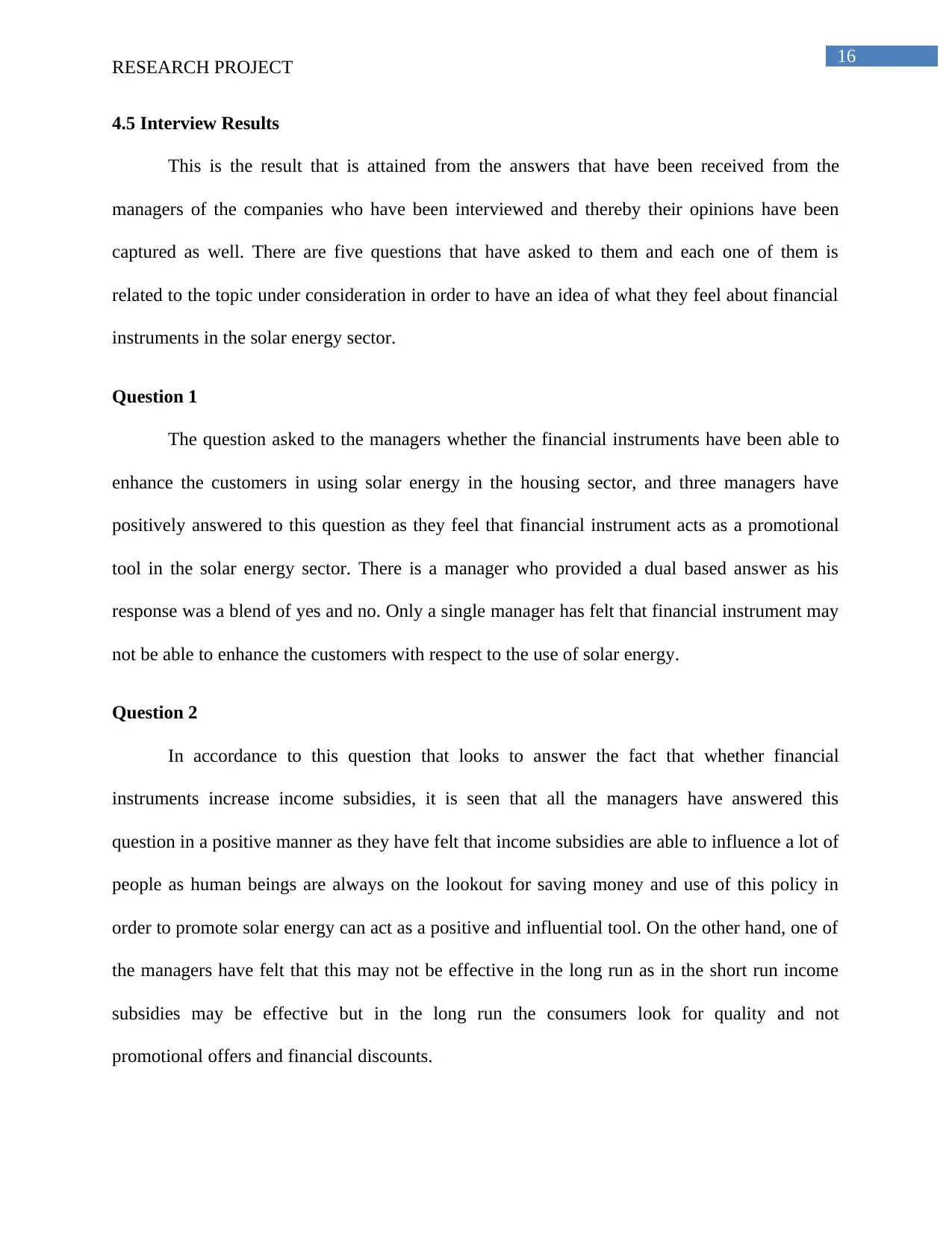
16
RESEARCH PROJECT
4.5 Interview Results
This is the result that is attained from the answers that have been received from the
managers of the companies who have been interviewed and thereby their opinions have been
captured as well. There are five questions that have asked to them and each one of them is
related to the topic under consideration in order to have an idea of what they feel about financial
instruments in the solar energy sector.
Question 1
The question asked to the managers whether the financial instruments have been able to
enhance the customers in using solar energy in the housing sector, and three managers have
positively answered to this question as they feel that financial instrument acts as a promotional
tool in the solar energy sector. There is a manager who provided a dual based answer as his
response was a blend of yes and no. Only a single manager has felt that financial instrument may
not be able to enhance the customers with respect to the use of solar energy.
Question 2
In accordance to this question that looks to answer the fact that whether financial
instruments increase income subsidies, it is seen that all the managers have answered this
question in a positive manner as they have felt that income subsidies are able to influence a lot of
people as human beings are always on the lookout for saving money and use of this policy in
order to promote solar energy can act as a positive and influential tool. On the other hand, one of
the managers have felt that this may not be effective in the long run as in the short run income
subsidies may be effective but in the long run the consumers look for quality and not
promotional offers and financial discounts.
RESEARCH PROJECT
4.5 Interview Results
This is the result that is attained from the answers that have been received from the
managers of the companies who have been interviewed and thereby their opinions have been
captured as well. There are five questions that have asked to them and each one of them is
related to the topic under consideration in order to have an idea of what they feel about financial
instruments in the solar energy sector.
Question 1
The question asked to the managers whether the financial instruments have been able to
enhance the customers in using solar energy in the housing sector, and three managers have
positively answered to this question as they feel that financial instrument acts as a promotional
tool in the solar energy sector. There is a manager who provided a dual based answer as his
response was a blend of yes and no. Only a single manager has felt that financial instrument may
not be able to enhance the customers with respect to the use of solar energy.
Question 2
In accordance to this question that looks to answer the fact that whether financial
instruments increase income subsidies, it is seen that all the managers have answered this
question in a positive manner as they have felt that income subsidies are able to influence a lot of
people as human beings are always on the lookout for saving money and use of this policy in
order to promote solar energy can act as a positive and influential tool. On the other hand, one of
the managers have felt that this may not be effective in the long run as in the short run income
subsidies may be effective but in the long run the consumers look for quality and not
promotional offers and financial discounts.
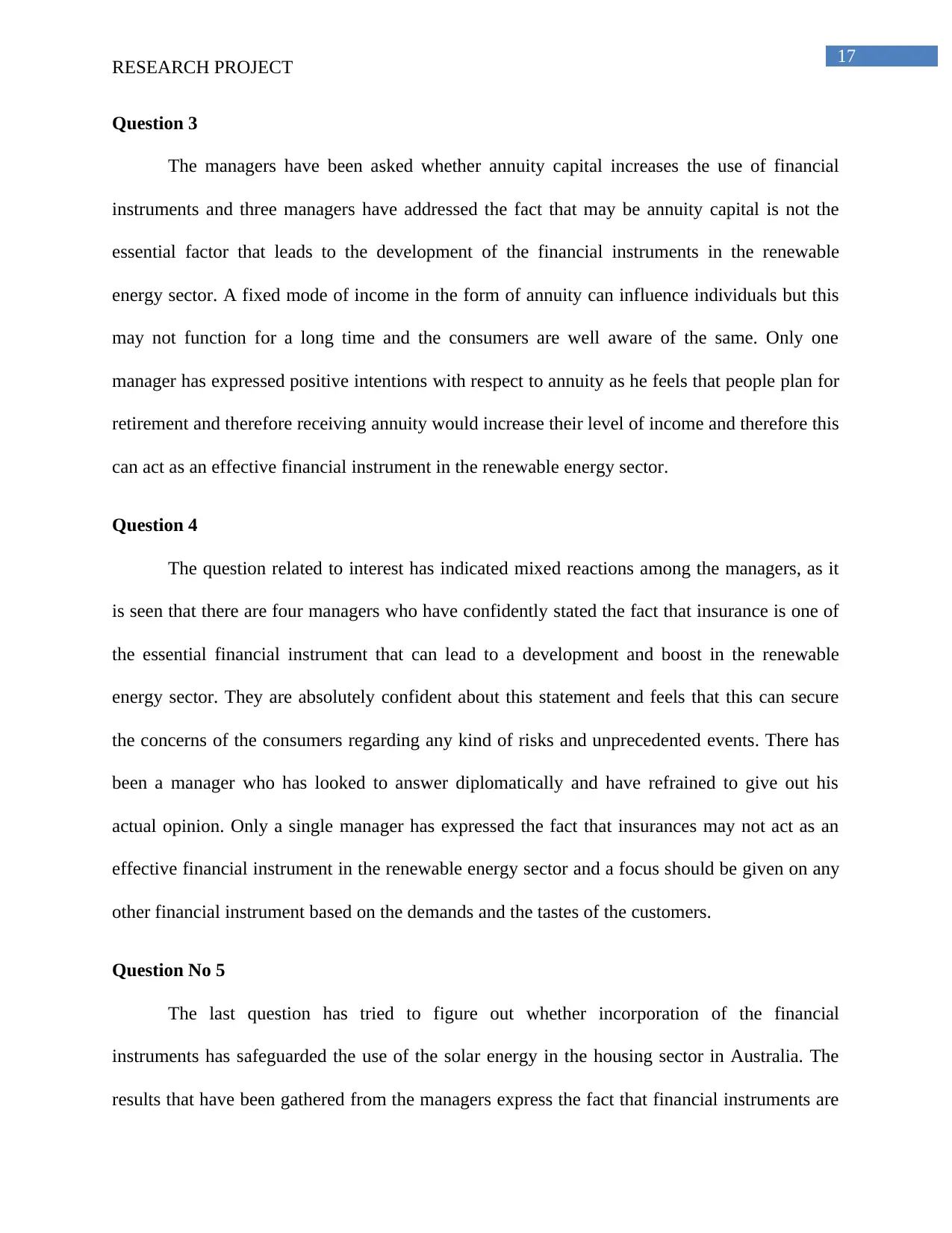
17
RESEARCH PROJECT
Question 3
The managers have been asked whether annuity capital increases the use of financial
instruments and three managers have addressed the fact that may be annuity capital is not the
essential factor that leads to the development of the financial instruments in the renewable
energy sector. A fixed mode of income in the form of annuity can influence individuals but this
may not function for a long time and the consumers are well aware of the same. Only one
manager has expressed positive intentions with respect to annuity as he feels that people plan for
retirement and therefore receiving annuity would increase their level of income and therefore this
can act as an effective financial instrument in the renewable energy sector.
Question 4
The question related to interest has indicated mixed reactions among the managers, as it
is seen that there are four managers who have confidently stated the fact that insurance is one of
the essential financial instrument that can lead to a development and boost in the renewable
energy sector. They are absolutely confident about this statement and feels that this can secure
the concerns of the consumers regarding any kind of risks and unprecedented events. There has
been a manager who has looked to answer diplomatically and have refrained to give out his
actual opinion. Only a single manager has expressed the fact that insurances may not act as an
effective financial instrument in the renewable energy sector and a focus should be given on any
other financial instrument based on the demands and the tastes of the customers.
Question No 5
The last question has tried to figure out whether incorporation of the financial
instruments has safeguarded the use of the solar energy in the housing sector in Australia. The
results that have been gathered from the managers express the fact that financial instruments are
RESEARCH PROJECT
Question 3
The managers have been asked whether annuity capital increases the use of financial
instruments and three managers have addressed the fact that may be annuity capital is not the
essential factor that leads to the development of the financial instruments in the renewable
energy sector. A fixed mode of income in the form of annuity can influence individuals but this
may not function for a long time and the consumers are well aware of the same. Only one
manager has expressed positive intentions with respect to annuity as he feels that people plan for
retirement and therefore receiving annuity would increase their level of income and therefore this
can act as an effective financial instrument in the renewable energy sector.
Question 4
The question related to interest has indicated mixed reactions among the managers, as it
is seen that there are four managers who have confidently stated the fact that insurance is one of
the essential financial instrument that can lead to a development and boost in the renewable
energy sector. They are absolutely confident about this statement and feels that this can secure
the concerns of the consumers regarding any kind of risks and unprecedented events. There has
been a manager who has looked to answer diplomatically and have refrained to give out his
actual opinion. Only a single manager has expressed the fact that insurances may not act as an
effective financial instrument in the renewable energy sector and a focus should be given on any
other financial instrument based on the demands and the tastes of the customers.
Question No 5
The last question has tried to figure out whether incorporation of the financial
instruments has safeguarded the use of the solar energy in the housing sector in Australia. The
results that have been gathered from the managers express the fact that financial instruments are
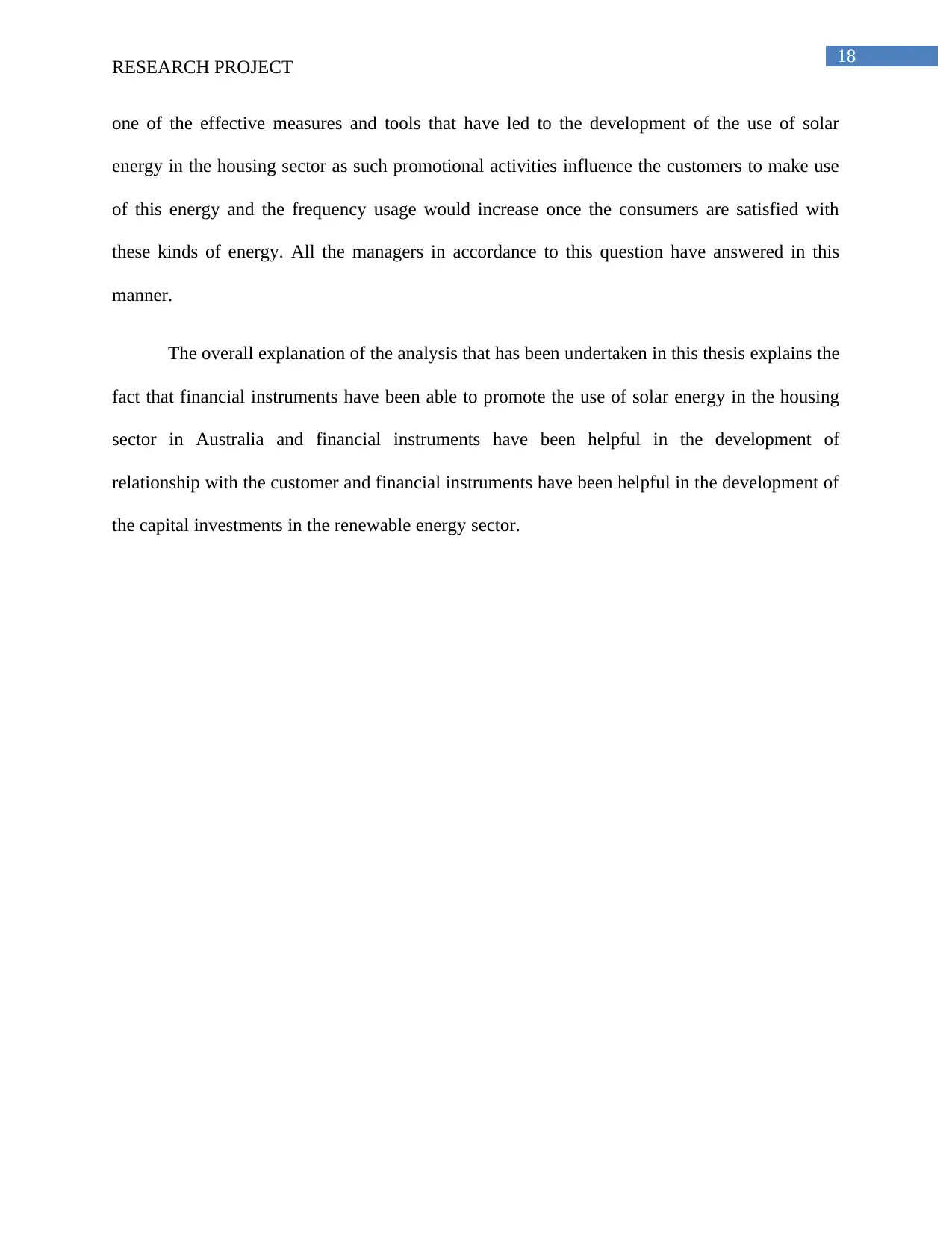
18
RESEARCH PROJECT
one of the effective measures and tools that have led to the development of the use of solar
energy in the housing sector as such promotional activities influence the customers to make use
of this energy and the frequency usage would increase once the consumers are satisfied with
these kinds of energy. All the managers in accordance to this question have answered in this
manner.
The overall explanation of the analysis that has been undertaken in this thesis explains the
fact that financial instruments have been able to promote the use of solar energy in the housing
sector in Australia and financial instruments have been helpful in the development of
relationship with the customer and financial instruments have been helpful in the development of
the capital investments in the renewable energy sector.
RESEARCH PROJECT
one of the effective measures and tools that have led to the development of the use of solar
energy in the housing sector as such promotional activities influence the customers to make use
of this energy and the frequency usage would increase once the consumers are satisfied with
these kinds of energy. All the managers in accordance to this question have answered in this
manner.
The overall explanation of the analysis that has been undertaken in this thesis explains the
fact that financial instruments have been able to promote the use of solar energy in the housing
sector in Australia and financial instruments have been helpful in the development of
relationship with the customer and financial instruments have been helpful in the development of
the capital investments in the renewable energy sector.
Paraphrase This Document
Need a fresh take? Get an instant paraphrase of this document with our AI Paraphraser
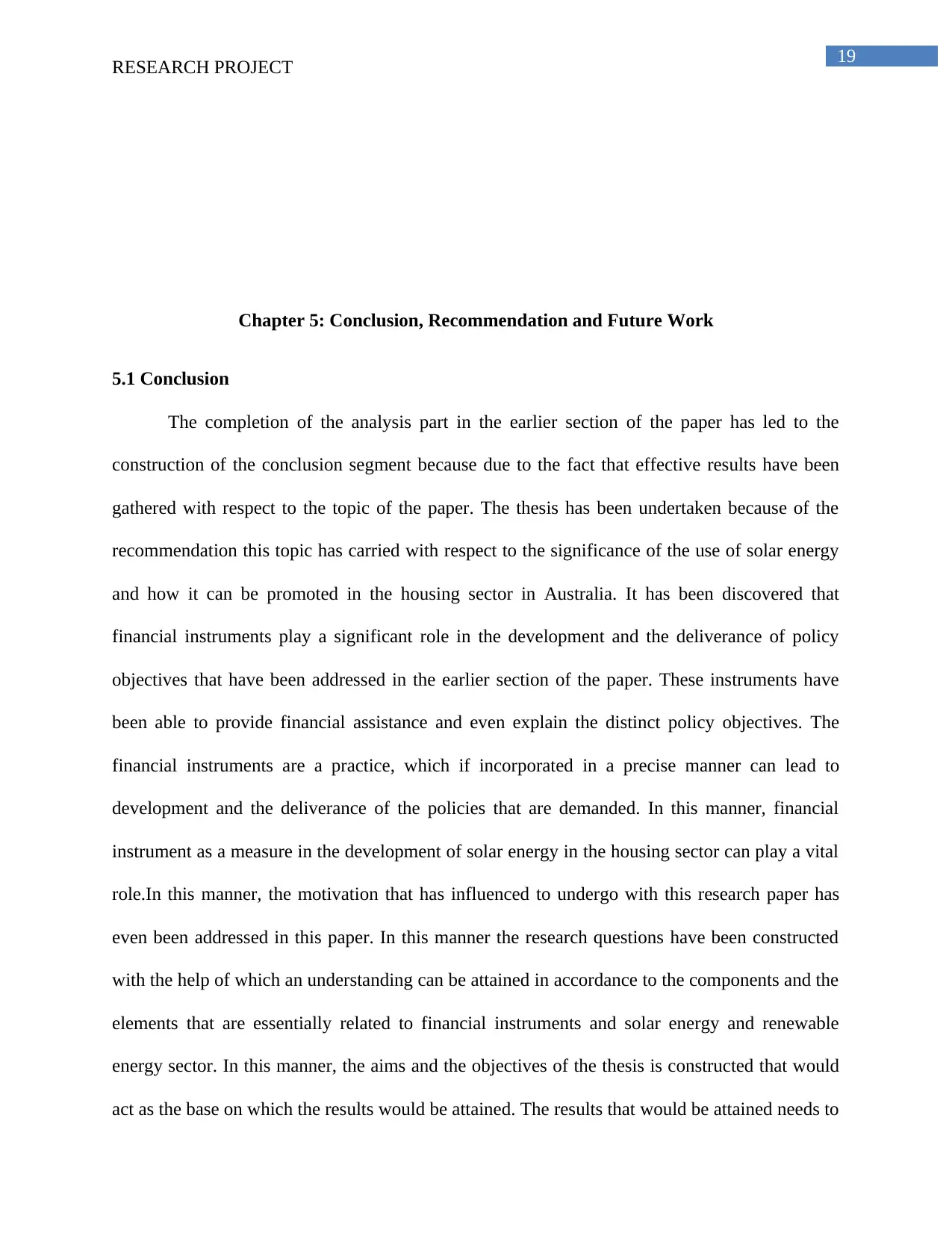
19
RESEARCH PROJECT
Chapter 5: Conclusion, Recommendation and Future Work
5.1 Conclusion
The completion of the analysis part in the earlier section of the paper has led to the
construction of the conclusion segment because due to the fact that effective results have been
gathered with respect to the topic of the paper. The thesis has been undertaken because of the
recommendation this topic has carried with respect to the significance of the use of solar energy
and how it can be promoted in the housing sector in Australia. It has been discovered that
financial instruments play a significant role in the development and the deliverance of policy
objectives that have been addressed in the earlier section of the paper. These instruments have
been able to provide financial assistance and even explain the distinct policy objectives. The
financial instruments are a practice, which if incorporated in a precise manner can lead to
development and the deliverance of the policies that are demanded. In this manner, financial
instrument as a measure in the development of solar energy in the housing sector can play a vital
role.In this manner, the motivation that has influenced to undergo with this research paper has
even been addressed in this paper. In this manner the research questions have been constructed
with the help of which an understanding can be attained in accordance to the components and the
elements that are essentially related to financial instruments and solar energy and renewable
energy sector. In this manner, the aims and the objectives of the thesis is constructed that would
act as the base on which the results would be attained. The results that would be attained needs to
RESEARCH PROJECT
Chapter 5: Conclusion, Recommendation and Future Work
5.1 Conclusion
The completion of the analysis part in the earlier section of the paper has led to the
construction of the conclusion segment because due to the fact that effective results have been
gathered with respect to the topic of the paper. The thesis has been undertaken because of the
recommendation this topic has carried with respect to the significance of the use of solar energy
and how it can be promoted in the housing sector in Australia. It has been discovered that
financial instruments play a significant role in the development and the deliverance of policy
objectives that have been addressed in the earlier section of the paper. These instruments have
been able to provide financial assistance and even explain the distinct policy objectives. The
financial instruments are a practice, which if incorporated in a precise manner can lead to
development and the deliverance of the policies that are demanded. In this manner, financial
instrument as a measure in the development of solar energy in the housing sector can play a vital
role.In this manner, the motivation that has influenced to undergo with this research paper has
even been addressed in this paper. In this manner the research questions have been constructed
with the help of which an understanding can be attained in accordance to the components and the
elements that are essentially related to financial instruments and solar energy and renewable
energy sector. In this manner, the aims and the objectives of the thesis is constructed that would
act as the base on which the results would be attained. The results that would be attained needs to
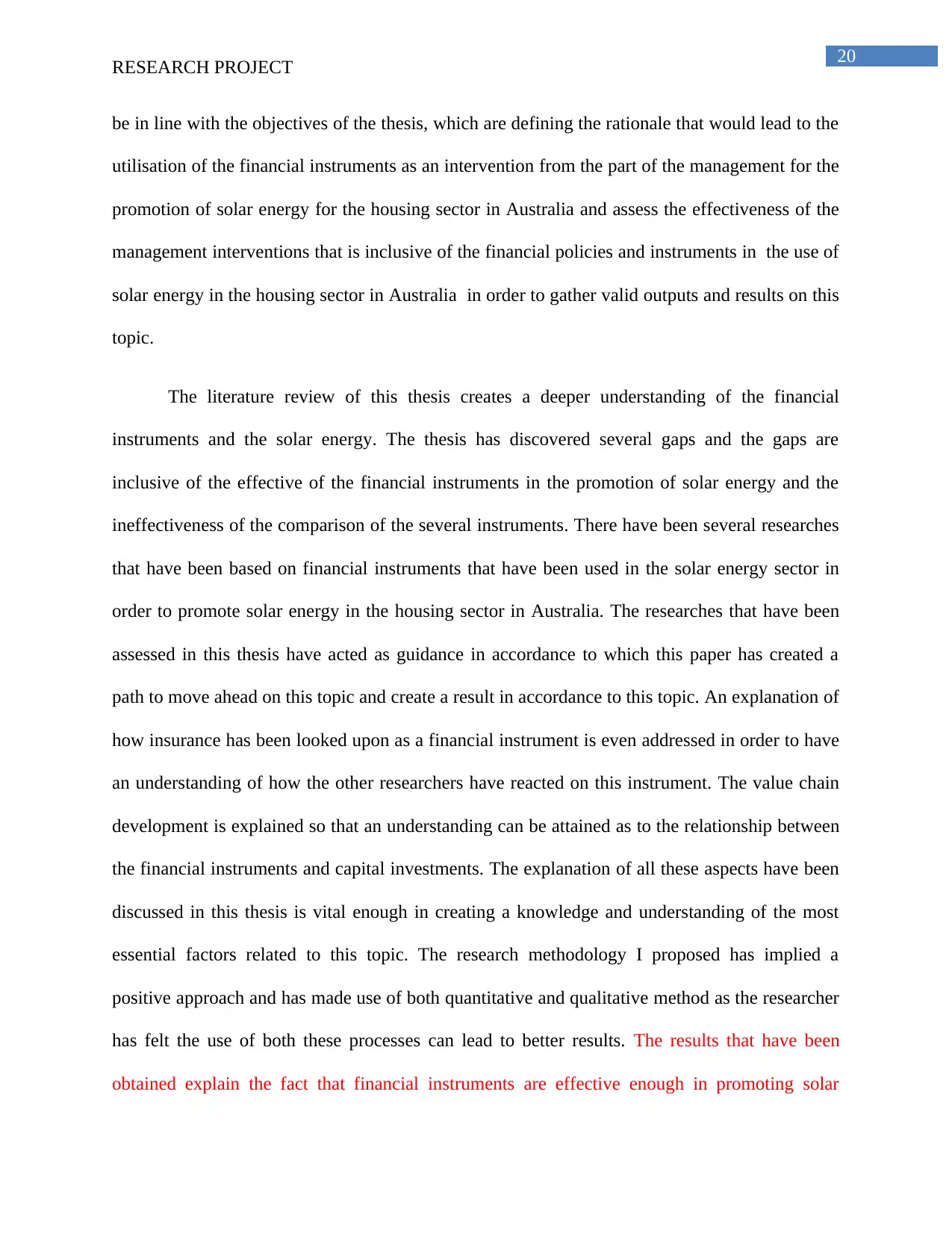
20
RESEARCH PROJECT
be in line with the objectives of the thesis, which are defining the rationale that would lead to the
utilisation of the financial instruments as an intervention from the part of the management for the
promotion of solar energy for the housing sector in Australia and assess the effectiveness of the
management interventions that is inclusive of the financial policies and instruments in the use of
solar energy in the housing sector in Australia in order to gather valid outputs and results on this
topic.
The literature review of this thesis creates a deeper understanding of the financial
instruments and the solar energy. The thesis has discovered several gaps and the gaps are
inclusive of the effective of the financial instruments in the promotion of solar energy and the
ineffectiveness of the comparison of the several instruments. There have been several researches
that have been based on financial instruments that have been used in the solar energy sector in
order to promote solar energy in the housing sector in Australia. The researches that have been
assessed in this thesis have acted as guidance in accordance to which this paper has created a
path to move ahead on this topic and create a result in accordance to this topic. An explanation of
how insurance has been looked upon as a financial instrument is even addressed in order to have
an understanding of how the other researchers have reacted on this instrument. The value chain
development is explained so that an understanding can be attained as to the relationship between
the financial instruments and capital investments. The explanation of all these aspects have been
discussed in this thesis is vital enough in creating a knowledge and understanding of the most
essential factors related to this topic. The research methodology I proposed has implied a
positive approach and has made use of both quantitative and qualitative method as the researcher
has felt the use of both these processes can lead to better results. The results that have been
obtained explain the fact that financial instruments are effective enough in promoting solar
RESEARCH PROJECT
be in line with the objectives of the thesis, which are defining the rationale that would lead to the
utilisation of the financial instruments as an intervention from the part of the management for the
promotion of solar energy for the housing sector in Australia and assess the effectiveness of the
management interventions that is inclusive of the financial policies and instruments in the use of
solar energy in the housing sector in Australia in order to gather valid outputs and results on this
topic.
The literature review of this thesis creates a deeper understanding of the financial
instruments and the solar energy. The thesis has discovered several gaps and the gaps are
inclusive of the effective of the financial instruments in the promotion of solar energy and the
ineffectiveness of the comparison of the several instruments. There have been several researches
that have been based on financial instruments that have been used in the solar energy sector in
order to promote solar energy in the housing sector in Australia. The researches that have been
assessed in this thesis have acted as guidance in accordance to which this paper has created a
path to move ahead on this topic and create a result in accordance to this topic. An explanation of
how insurance has been looked upon as a financial instrument is even addressed in order to have
an understanding of how the other researchers have reacted on this instrument. The value chain
development is explained so that an understanding can be attained as to the relationship between
the financial instruments and capital investments. The explanation of all these aspects have been
discussed in this thesis is vital enough in creating a knowledge and understanding of the most
essential factors related to this topic. The research methodology I proposed has implied a
positive approach and has made use of both quantitative and qualitative method as the researcher
has felt the use of both these processes can lead to better results. The results that have been
obtained explain the fact that financial instruments are effective enough in promoting solar
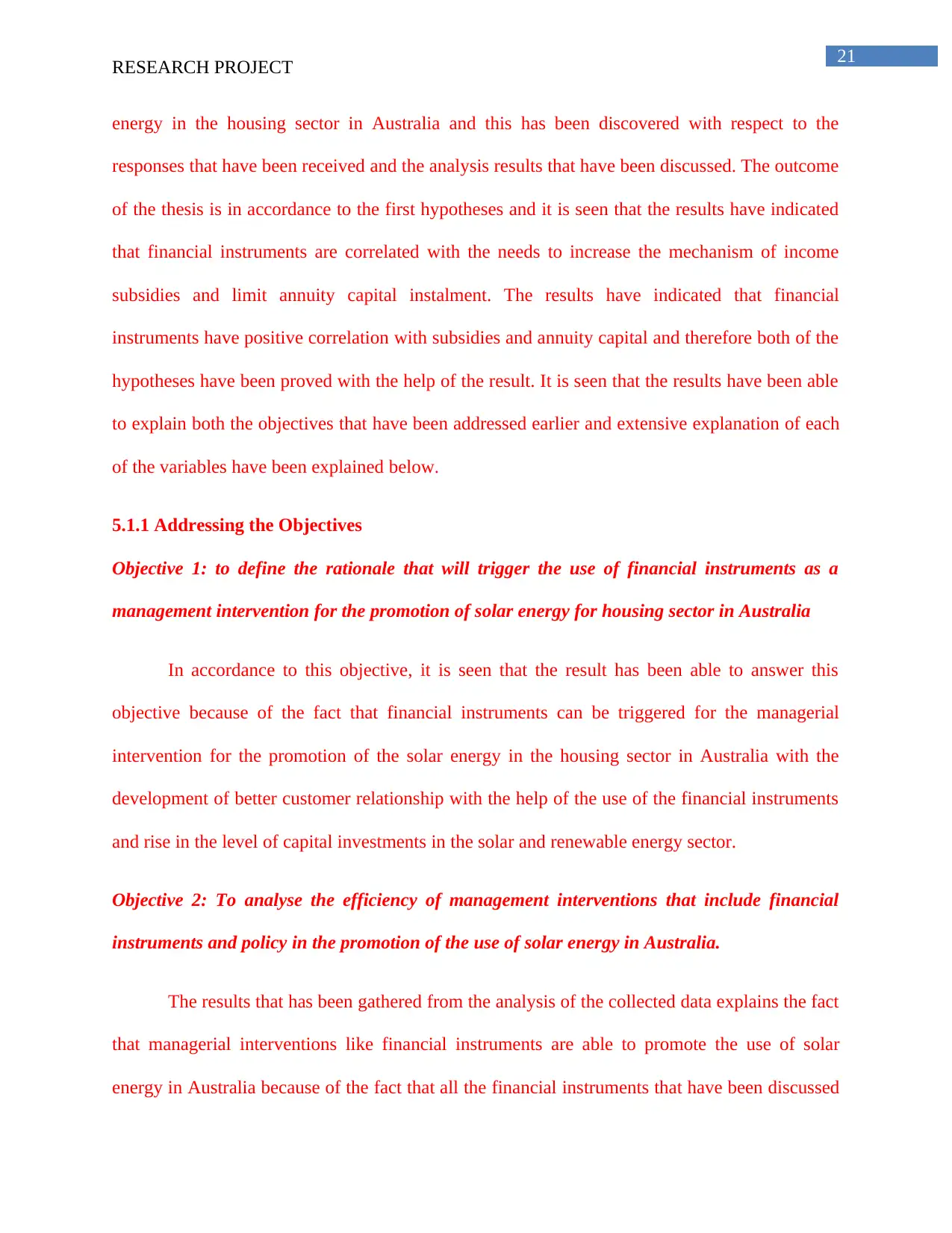
21
RESEARCH PROJECT
energy in the housing sector in Australia and this has been discovered with respect to the
responses that have been received and the analysis results that have been discussed. The outcome
of the thesis is in accordance to the first hypotheses and it is seen that the results have indicated
that financial instruments are correlated with the needs to increase the mechanism of income
subsidies and limit annuity capital instalment. The results have indicated that financial
instruments have positive correlation with subsidies and annuity capital and therefore both of the
hypotheses have been proved with the help of the result. It is seen that the results have been able
to explain both the objectives that have been addressed earlier and extensive explanation of each
of the variables have been explained below.
5.1.1 Addressing the Objectives
Objective 1: to define the rationale that will trigger the use of financial instruments as a
management intervention for the promotion of solar energy for housing sector in Australia
In accordance to this objective, it is seen that the result has been able to answer this
objective because of the fact that financial instruments can be triggered for the managerial
intervention for the promotion of the solar energy in the housing sector in Australia with the
development of better customer relationship with the help of the use of the financial instruments
and rise in the level of capital investments in the solar and renewable energy sector.
Objective 2: To analyse the efficiency of management interventions that include financial
instruments and policy in the promotion of the use of solar energy in Australia.
The results that has been gathered from the analysis of the collected data explains the fact
that managerial interventions like financial instruments are able to promote the use of solar
energy in Australia because of the fact that all the financial instruments that have been discussed
RESEARCH PROJECT
energy in the housing sector in Australia and this has been discovered with respect to the
responses that have been received and the analysis results that have been discussed. The outcome
of the thesis is in accordance to the first hypotheses and it is seen that the results have indicated
that financial instruments are correlated with the needs to increase the mechanism of income
subsidies and limit annuity capital instalment. The results have indicated that financial
instruments have positive correlation with subsidies and annuity capital and therefore both of the
hypotheses have been proved with the help of the result. It is seen that the results have been able
to explain both the objectives that have been addressed earlier and extensive explanation of each
of the variables have been explained below.
5.1.1 Addressing the Objectives
Objective 1: to define the rationale that will trigger the use of financial instruments as a
management intervention for the promotion of solar energy for housing sector in Australia
In accordance to this objective, it is seen that the result has been able to answer this
objective because of the fact that financial instruments can be triggered for the managerial
intervention for the promotion of the solar energy in the housing sector in Australia with the
development of better customer relationship with the help of the use of the financial instruments
and rise in the level of capital investments in the solar and renewable energy sector.
Objective 2: To analyse the efficiency of management interventions that include financial
instruments and policy in the promotion of the use of solar energy in Australia.
The results that has been gathered from the analysis of the collected data explains the fact
that managerial interventions like financial instruments are able to promote the use of solar
energy in Australia because of the fact that all the financial instruments that have been discussed
Secure Best Marks with AI Grader
Need help grading? Try our AI Grader for instant feedback on your assignments.
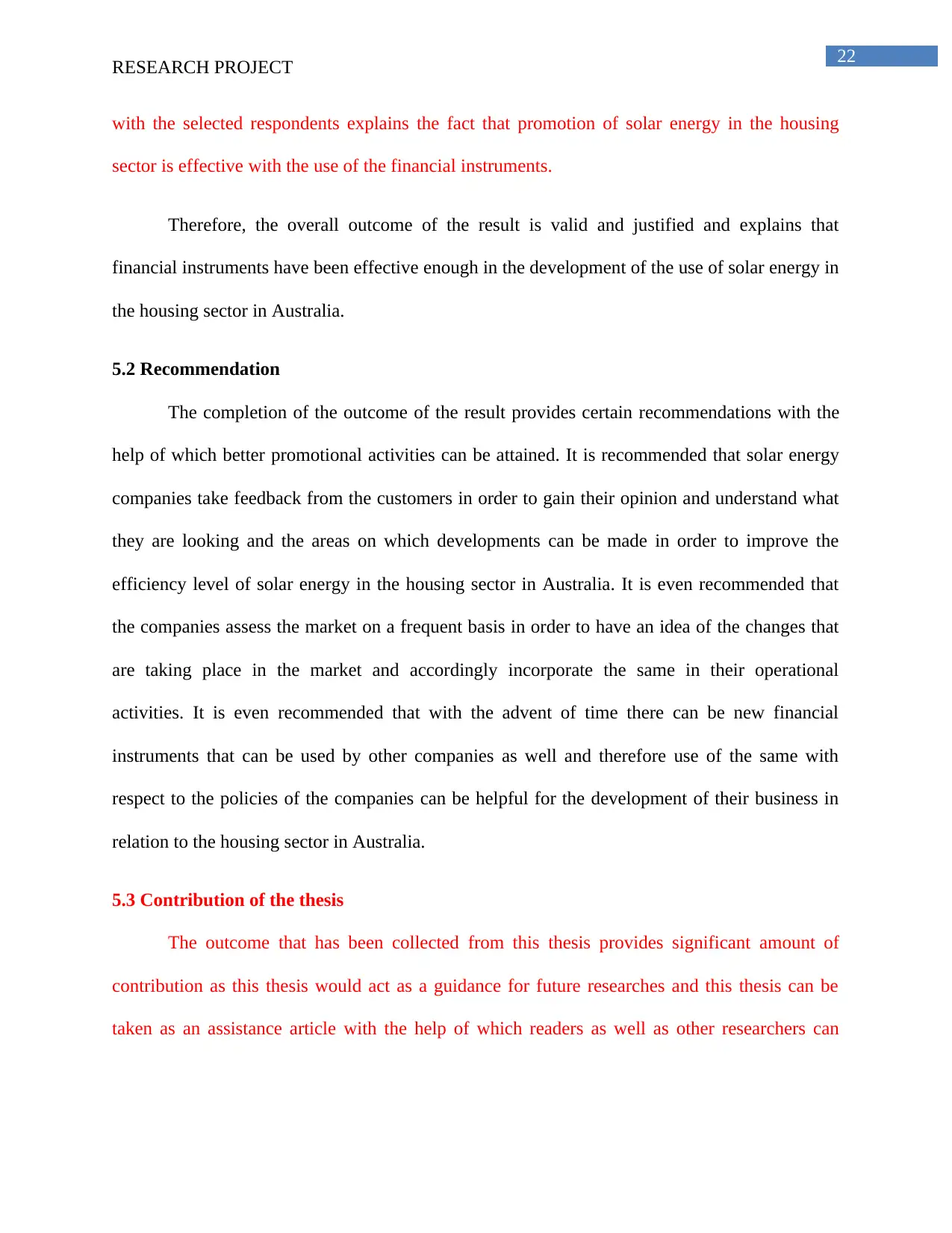
22
RESEARCH PROJECT
with the selected respondents explains the fact that promotion of solar energy in the housing
sector is effective with the use of the financial instruments.
Therefore, the overall outcome of the result is valid and justified and explains that
financial instruments have been effective enough in the development of the use of solar energy in
the housing sector in Australia.
5.2 Recommendation
The completion of the outcome of the result provides certain recommendations with the
help of which better promotional activities can be attained. It is recommended that solar energy
companies take feedback from the customers in order to gain their opinion and understand what
they are looking and the areas on which developments can be made in order to improve the
efficiency level of solar energy in the housing sector in Australia. It is even recommended that
the companies assess the market on a frequent basis in order to have an idea of the changes that
are taking place in the market and accordingly incorporate the same in their operational
activities. It is even recommended that with the advent of time there can be new financial
instruments that can be used by other companies as well and therefore use of the same with
respect to the policies of the companies can be helpful for the development of their business in
relation to the housing sector in Australia.
5.3 Contribution of the thesis
The outcome that has been collected from this thesis provides significant amount of
contribution as this thesis would act as a guidance for future researches and this thesis can be
taken as an assistance article with the help of which readers as well as other researchers can
RESEARCH PROJECT
with the selected respondents explains the fact that promotion of solar energy in the housing
sector is effective with the use of the financial instruments.
Therefore, the overall outcome of the result is valid and justified and explains that
financial instruments have been effective enough in the development of the use of solar energy in
the housing sector in Australia.
5.2 Recommendation
The completion of the outcome of the result provides certain recommendations with the
help of which better promotional activities can be attained. It is recommended that solar energy
companies take feedback from the customers in order to gain their opinion and understand what
they are looking and the areas on which developments can be made in order to improve the
efficiency level of solar energy in the housing sector in Australia. It is even recommended that
the companies assess the market on a frequent basis in order to have an idea of the changes that
are taking place in the market and accordingly incorporate the same in their operational
activities. It is even recommended that with the advent of time there can be new financial
instruments that can be used by other companies as well and therefore use of the same with
respect to the policies of the companies can be helpful for the development of their business in
relation to the housing sector in Australia.
5.3 Contribution of the thesis
The outcome that has been collected from this thesis provides significant amount of
contribution as this thesis would act as a guidance for future researches and this thesis can be
taken as an assistance article with the help of which readers as well as other researchers can
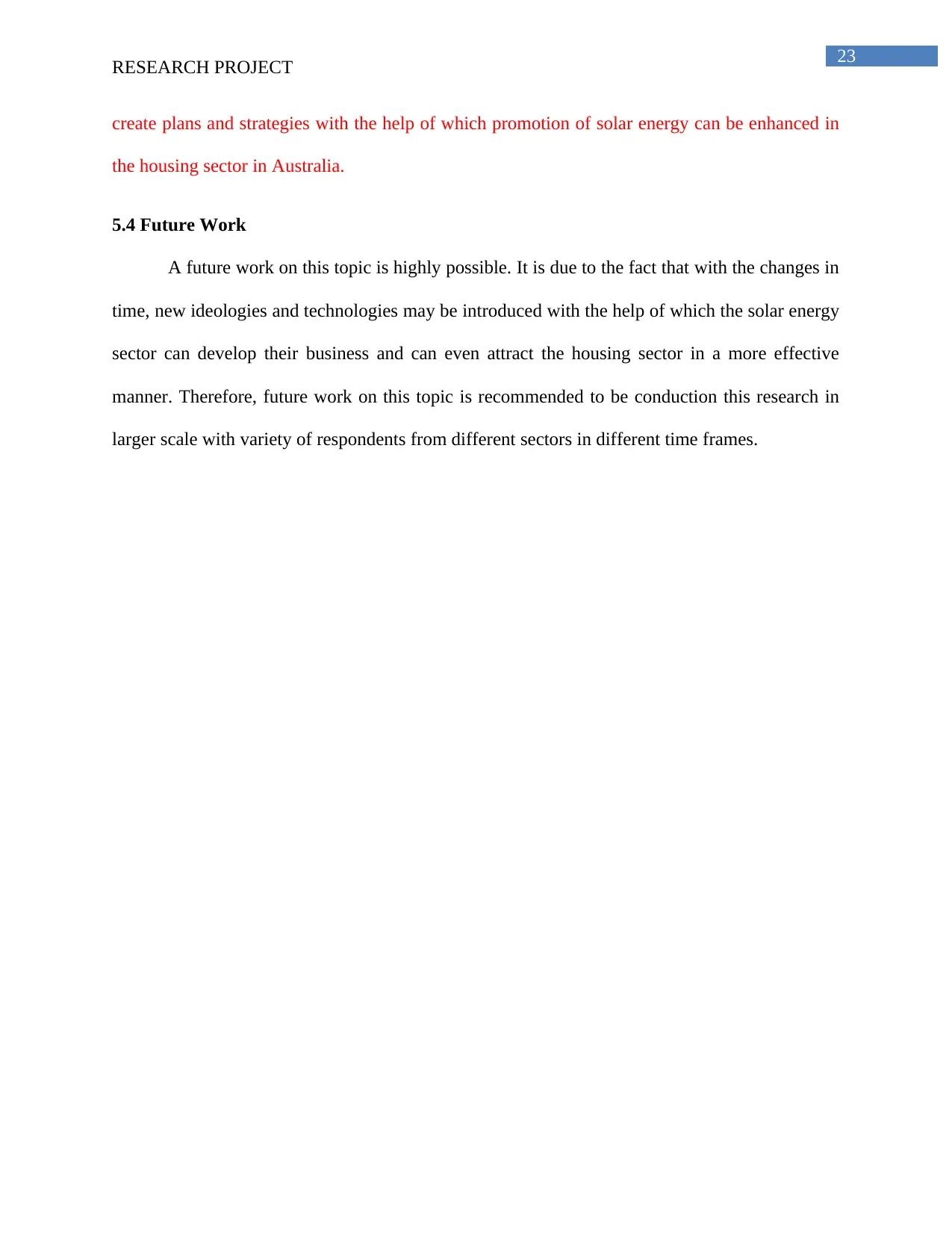
23
RESEARCH PROJECT
create plans and strategies with the help of which promotion of solar energy can be enhanced in
the housing sector in Australia.
5.4 Future Work
A future work on this topic is highly possible. It is due to the fact that with the changes in
time, new ideologies and technologies may be introduced with the help of which the solar energy
sector can develop their business and can even attract the housing sector in a more effective
manner. Therefore, future work on this topic is recommended to be conduction this research in
larger scale with variety of respondents from different sectors in different time frames.
RESEARCH PROJECT
create plans and strategies with the help of which promotion of solar energy can be enhanced in
the housing sector in Australia.
5.4 Future Work
A future work on this topic is highly possible. It is due to the fact that with the changes in
time, new ideologies and technologies may be introduced with the help of which the solar energy
sector can develop their business and can even attract the housing sector in a more effective
manner. Therefore, future work on this topic is recommended to be conduction this research in
larger scale with variety of respondents from different sectors in different time frames.
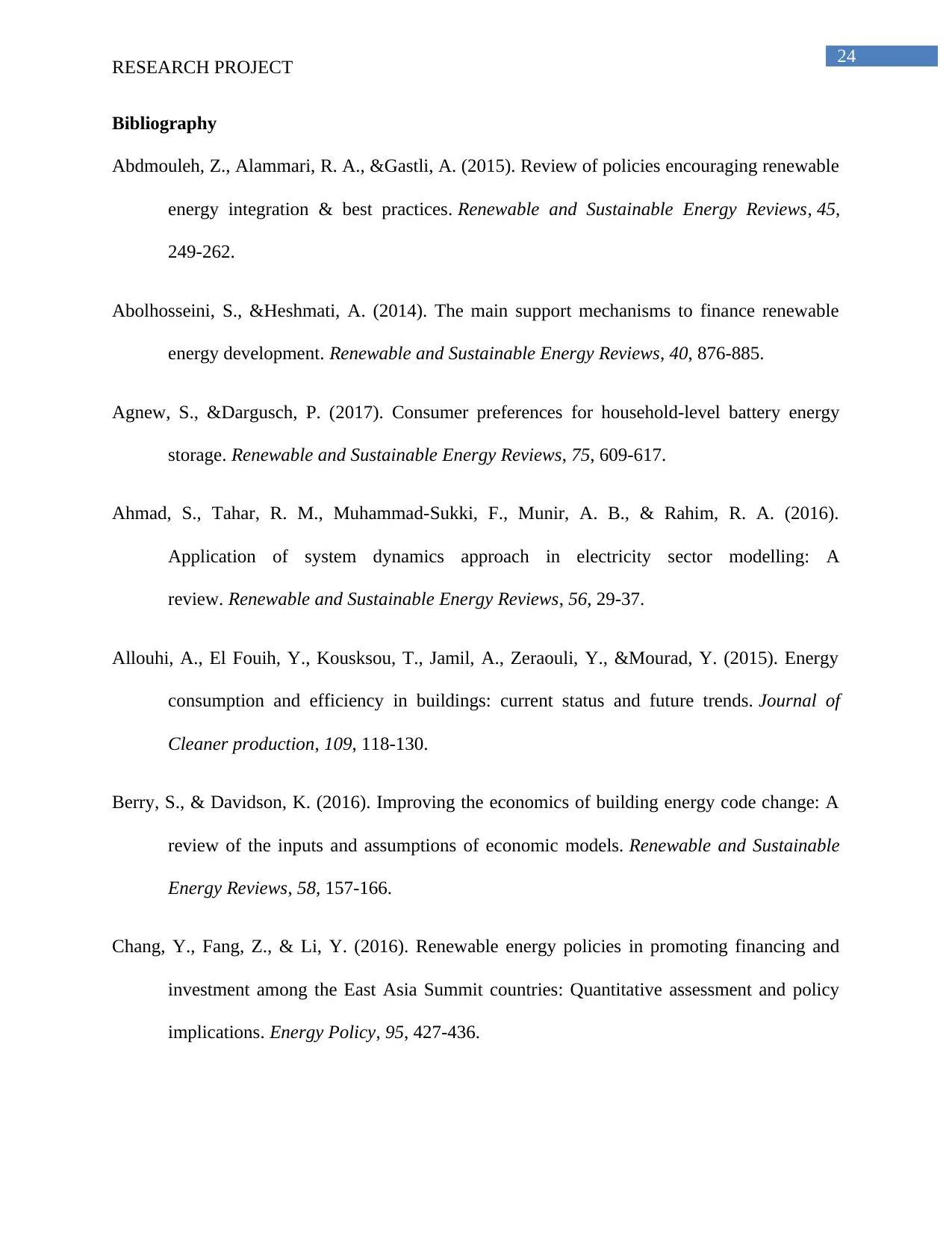
24
RESEARCH PROJECT
Bibliography
Abdmouleh, Z., Alammari, R. A., &Gastli, A. (2015). Review of policies encouraging renewable
energy integration & best practices. Renewable and Sustainable Energy Reviews, 45,
249-262.
Abolhosseini, S., &Heshmati, A. (2014). The main support mechanisms to finance renewable
energy development. Renewable and Sustainable Energy Reviews, 40, 876-885.
Agnew, S., &Dargusch, P. (2017). Consumer preferences for household-level battery energy
storage. Renewable and Sustainable Energy Reviews, 75, 609-617.
Ahmad, S., Tahar, R. M., Muhammad-Sukki, F., Munir, A. B., & Rahim, R. A. (2016).
Application of system dynamics approach in electricity sector modelling: A
review. Renewable and Sustainable Energy Reviews, 56, 29-37.
Allouhi, A., El Fouih, Y., Kousksou, T., Jamil, A., Zeraouli, Y., &Mourad, Y. (2015). Energy
consumption and efficiency in buildings: current status and future trends. Journal of
Cleaner production, 109, 118-130.
Berry, S., & Davidson, K. (2016). Improving the economics of building energy code change: A
review of the inputs and assumptions of economic models. Renewable and Sustainable
Energy Reviews, 58, 157-166.
Chang, Y., Fang, Z., & Li, Y. (2016). Renewable energy policies in promoting financing and
investment among the East Asia Summit countries: Quantitative assessment and policy
implications. Energy Policy, 95, 427-436.
RESEARCH PROJECT
Bibliography
Abdmouleh, Z., Alammari, R. A., &Gastli, A. (2015). Review of policies encouraging renewable
energy integration & best practices. Renewable and Sustainable Energy Reviews, 45,
249-262.
Abolhosseini, S., &Heshmati, A. (2014). The main support mechanisms to finance renewable
energy development. Renewable and Sustainable Energy Reviews, 40, 876-885.
Agnew, S., &Dargusch, P. (2017). Consumer preferences for household-level battery energy
storage. Renewable and Sustainable Energy Reviews, 75, 609-617.
Ahmad, S., Tahar, R. M., Muhammad-Sukki, F., Munir, A. B., & Rahim, R. A. (2016).
Application of system dynamics approach in electricity sector modelling: A
review. Renewable and Sustainable Energy Reviews, 56, 29-37.
Allouhi, A., El Fouih, Y., Kousksou, T., Jamil, A., Zeraouli, Y., &Mourad, Y. (2015). Energy
consumption and efficiency in buildings: current status and future trends. Journal of
Cleaner production, 109, 118-130.
Berry, S., & Davidson, K. (2016). Improving the economics of building energy code change: A
review of the inputs and assumptions of economic models. Renewable and Sustainable
Energy Reviews, 58, 157-166.
Chang, Y., Fang, Z., & Li, Y. (2016). Renewable energy policies in promoting financing and
investment among the East Asia Summit countries: Quantitative assessment and policy
implications. Energy Policy, 95, 427-436.
Paraphrase This Document
Need a fresh take? Get an instant paraphrase of this document with our AI Paraphraser
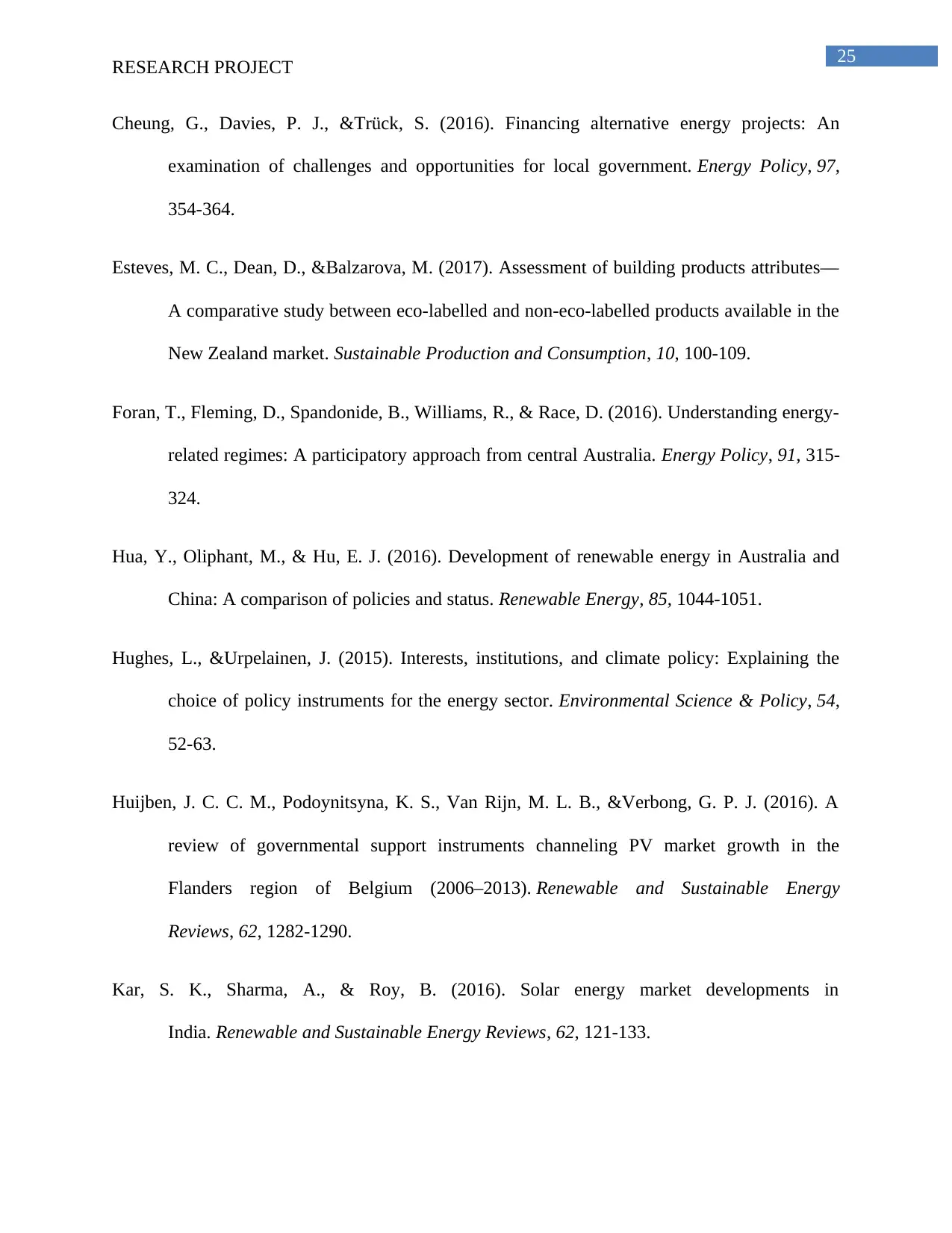
25
RESEARCH PROJECT
Cheung, G., Davies, P. J., &Trück, S. (2016). Financing alternative energy projects: An
examination of challenges and opportunities for local government. Energy Policy, 97,
354-364.
Esteves, M. C., Dean, D., &Balzarova, M. (2017). Assessment of building products attributes—
A comparative study between eco-labelled and non-eco-labelled products available in the
New Zealand market. Sustainable Production and Consumption, 10, 100-109.
Foran, T., Fleming, D., Spandonide, B., Williams, R., & Race, D. (2016). Understanding energy-
related regimes: A participatory approach from central Australia. Energy Policy, 91, 315-
324.
Hua, Y., Oliphant, M., & Hu, E. J. (2016). Development of renewable energy in Australia and
China: A comparison of policies and status. Renewable Energy, 85, 1044-1051.
Hughes, L., &Urpelainen, J. (2015). Interests, institutions, and climate policy: Explaining the
choice of policy instruments for the energy sector. Environmental Science & Policy, 54,
52-63.
Huijben, J. C. C. M., Podoynitsyna, K. S., Van Rijn, M. L. B., &Verbong, G. P. J. (2016). A
review of governmental support instruments channeling PV market growth in the
Flanders region of Belgium (2006–2013). Renewable and Sustainable Energy
Reviews, 62, 1282-1290.
Kar, S. K., Sharma, A., & Roy, B. (2016). Solar energy market developments in
India. Renewable and Sustainable Energy Reviews, 62, 121-133.
RESEARCH PROJECT
Cheung, G., Davies, P. J., &Trück, S. (2016). Financing alternative energy projects: An
examination of challenges and opportunities for local government. Energy Policy, 97,
354-364.
Esteves, M. C., Dean, D., &Balzarova, M. (2017). Assessment of building products attributes—
A comparative study between eco-labelled and non-eco-labelled products available in the
New Zealand market. Sustainable Production and Consumption, 10, 100-109.
Foran, T., Fleming, D., Spandonide, B., Williams, R., & Race, D. (2016). Understanding energy-
related regimes: A participatory approach from central Australia. Energy Policy, 91, 315-
324.
Hua, Y., Oliphant, M., & Hu, E. J. (2016). Development of renewable energy in Australia and
China: A comparison of policies and status. Renewable Energy, 85, 1044-1051.
Hughes, L., &Urpelainen, J. (2015). Interests, institutions, and climate policy: Explaining the
choice of policy instruments for the energy sector. Environmental Science & Policy, 54,
52-63.
Huijben, J. C. C. M., Podoynitsyna, K. S., Van Rijn, M. L. B., &Verbong, G. P. J. (2016). A
review of governmental support instruments channeling PV market growth in the
Flanders region of Belgium (2006–2013). Renewable and Sustainable Energy
Reviews, 62, 1282-1290.
Kar, S. K., Sharma, A., & Roy, B. (2016). Solar energy market developments in
India. Renewable and Sustainable Energy Reviews, 62, 121-133.
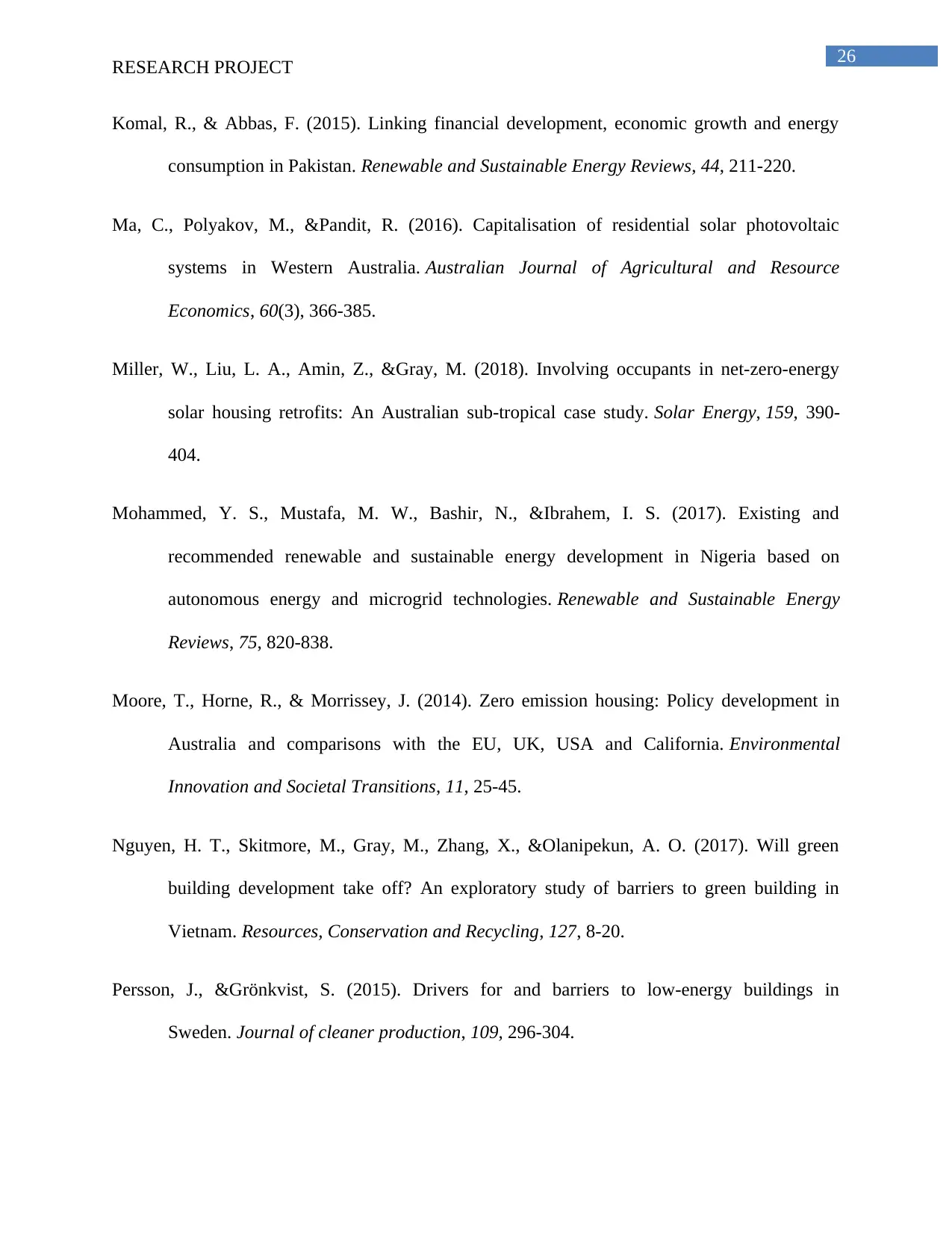
26
RESEARCH PROJECT
Komal, R., & Abbas, F. (2015). Linking financial development, economic growth and energy
consumption in Pakistan. Renewable and Sustainable Energy Reviews, 44, 211-220.
Ma, C., Polyakov, M., &Pandit, R. (2016). Capitalisation of residential solar photovoltaic
systems in Western Australia. Australian Journal of Agricultural and Resource
Economics, 60(3), 366-385.
Miller, W., Liu, L. A., Amin, Z., &Gray, M. (2018). Involving occupants in net-zero-energy
solar housing retrofits: An Australian sub-tropical case study. Solar Energy, 159, 390-
404.
Mohammed, Y. S., Mustafa, M. W., Bashir, N., &Ibrahem, I. S. (2017). Existing and
recommended renewable and sustainable energy development in Nigeria based on
autonomous energy and microgrid technologies. Renewable and Sustainable Energy
Reviews, 75, 820-838.
Moore, T., Horne, R., & Morrissey, J. (2014). Zero emission housing: Policy development in
Australia and comparisons with the EU, UK, USA and California. Environmental
Innovation and Societal Transitions, 11, 25-45.
Nguyen, H. T., Skitmore, M., Gray, M., Zhang, X., &Olanipekun, A. O. (2017). Will green
building development take off? An exploratory study of barriers to green building in
Vietnam. Resources, Conservation and Recycling, 127, 8-20.
Persson, J., &Grönkvist, S. (2015). Drivers for and barriers to low-energy buildings in
Sweden. Journal of cleaner production, 109, 296-304.
RESEARCH PROJECT
Komal, R., & Abbas, F. (2015). Linking financial development, economic growth and energy
consumption in Pakistan. Renewable and Sustainable Energy Reviews, 44, 211-220.
Ma, C., Polyakov, M., &Pandit, R. (2016). Capitalisation of residential solar photovoltaic
systems in Western Australia. Australian Journal of Agricultural and Resource
Economics, 60(3), 366-385.
Miller, W., Liu, L. A., Amin, Z., &Gray, M. (2018). Involving occupants in net-zero-energy
solar housing retrofits: An Australian sub-tropical case study. Solar Energy, 159, 390-
404.
Mohammed, Y. S., Mustafa, M. W., Bashir, N., &Ibrahem, I. S. (2017). Existing and
recommended renewable and sustainable energy development in Nigeria based on
autonomous energy and microgrid technologies. Renewable and Sustainable Energy
Reviews, 75, 820-838.
Moore, T., Horne, R., & Morrissey, J. (2014). Zero emission housing: Policy development in
Australia and comparisons with the EU, UK, USA and California. Environmental
Innovation and Societal Transitions, 11, 25-45.
Nguyen, H. T., Skitmore, M., Gray, M., Zhang, X., &Olanipekun, A. O. (2017). Will green
building development take off? An exploratory study of barriers to green building in
Vietnam. Resources, Conservation and Recycling, 127, 8-20.
Persson, J., &Grönkvist, S. (2015). Drivers for and barriers to low-energy buildings in
Sweden. Journal of cleaner production, 109, 296-304.
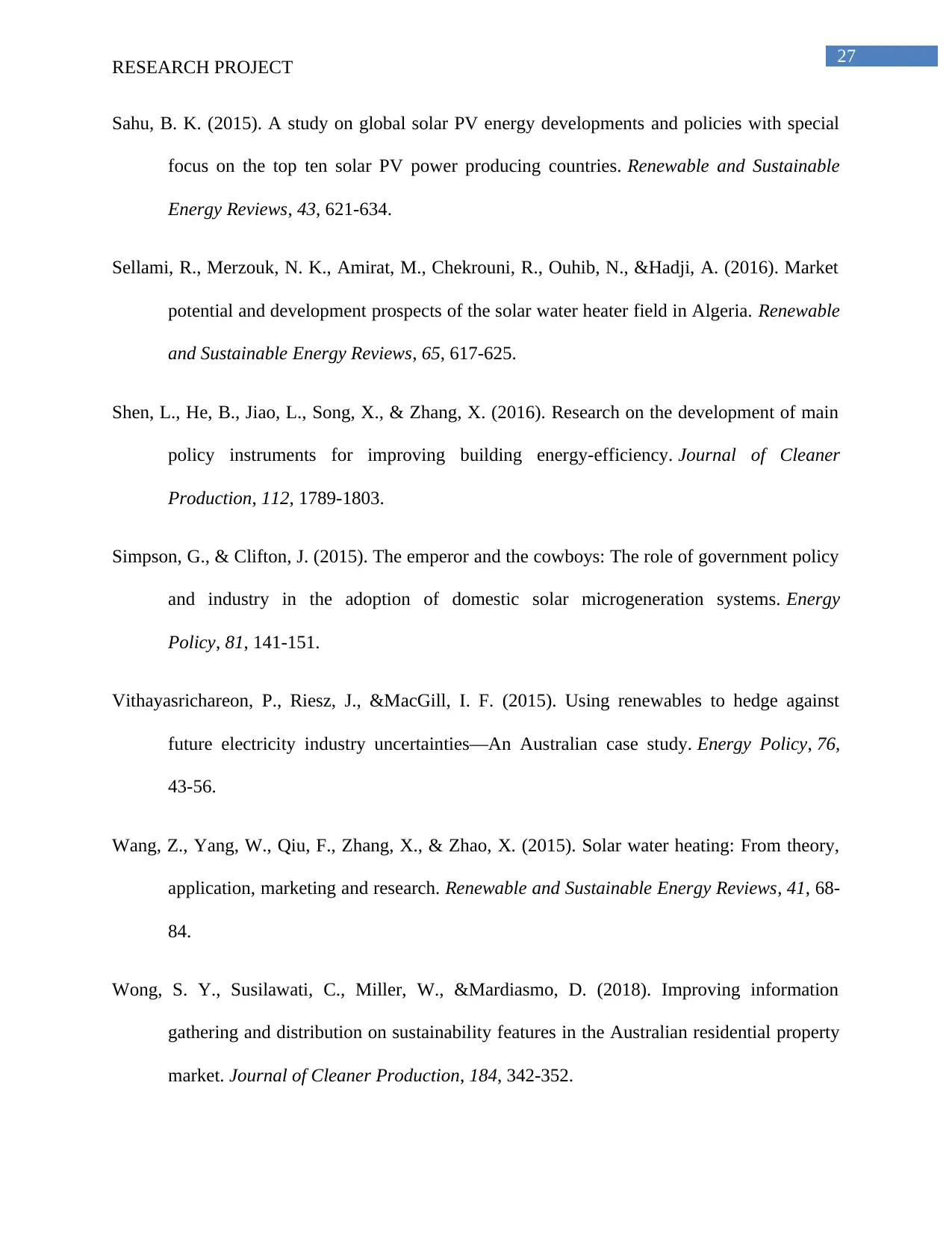
27
RESEARCH PROJECT
Sahu, B. K. (2015). A study on global solar PV energy developments and policies with special
focus on the top ten solar PV power producing countries. Renewable and Sustainable
Energy Reviews, 43, 621-634.
Sellami, R., Merzouk, N. K., Amirat, M., Chekrouni, R., Ouhib, N., &Hadji, A. (2016). Market
potential and development prospects of the solar water heater field in Algeria. Renewable
and Sustainable Energy Reviews, 65, 617-625.
Shen, L., He, B., Jiao, L., Song, X., & Zhang, X. (2016). Research on the development of main
policy instruments for improving building energy-efficiency. Journal of Cleaner
Production, 112, 1789-1803.
Simpson, G., & Clifton, J. (2015). The emperor and the cowboys: The role of government policy
and industry in the adoption of domestic solar microgeneration systems. Energy
Policy, 81, 141-151.
Vithayasrichareon, P., Riesz, J., &MacGill, I. F. (2015). Using renewables to hedge against
future electricity industry uncertainties—An Australian case study. Energy Policy, 76,
43-56.
Wang, Z., Yang, W., Qiu, F., Zhang, X., & Zhao, X. (2015). Solar water heating: From theory,
application, marketing and research. Renewable and Sustainable Energy Reviews, 41, 68-
84.
Wong, S. Y., Susilawati, C., Miller, W., &Mardiasmo, D. (2018). Improving information
gathering and distribution on sustainability features in the Australian residential property
market. Journal of Cleaner Production, 184, 342-352.
RESEARCH PROJECT
Sahu, B. K. (2015). A study on global solar PV energy developments and policies with special
focus on the top ten solar PV power producing countries. Renewable and Sustainable
Energy Reviews, 43, 621-634.
Sellami, R., Merzouk, N. K., Amirat, M., Chekrouni, R., Ouhib, N., &Hadji, A. (2016). Market
potential and development prospects of the solar water heater field in Algeria. Renewable
and Sustainable Energy Reviews, 65, 617-625.
Shen, L., He, B., Jiao, L., Song, X., & Zhang, X. (2016). Research on the development of main
policy instruments for improving building energy-efficiency. Journal of Cleaner
Production, 112, 1789-1803.
Simpson, G., & Clifton, J. (2015). The emperor and the cowboys: The role of government policy
and industry in the adoption of domestic solar microgeneration systems. Energy
Policy, 81, 141-151.
Vithayasrichareon, P., Riesz, J., &MacGill, I. F. (2015). Using renewables to hedge against
future electricity industry uncertainties—An Australian case study. Energy Policy, 76,
43-56.
Wang, Z., Yang, W., Qiu, F., Zhang, X., & Zhao, X. (2015). Solar water heating: From theory,
application, marketing and research. Renewable and Sustainable Energy Reviews, 41, 68-
84.
Wong, S. Y., Susilawati, C., Miller, W., &Mardiasmo, D. (2018). Improving information
gathering and distribution on sustainability features in the Australian residential property
market. Journal of Cleaner Production, 184, 342-352.
Secure Best Marks with AI Grader
Need help grading? Try our AI Grader for instant feedback on your assignments.
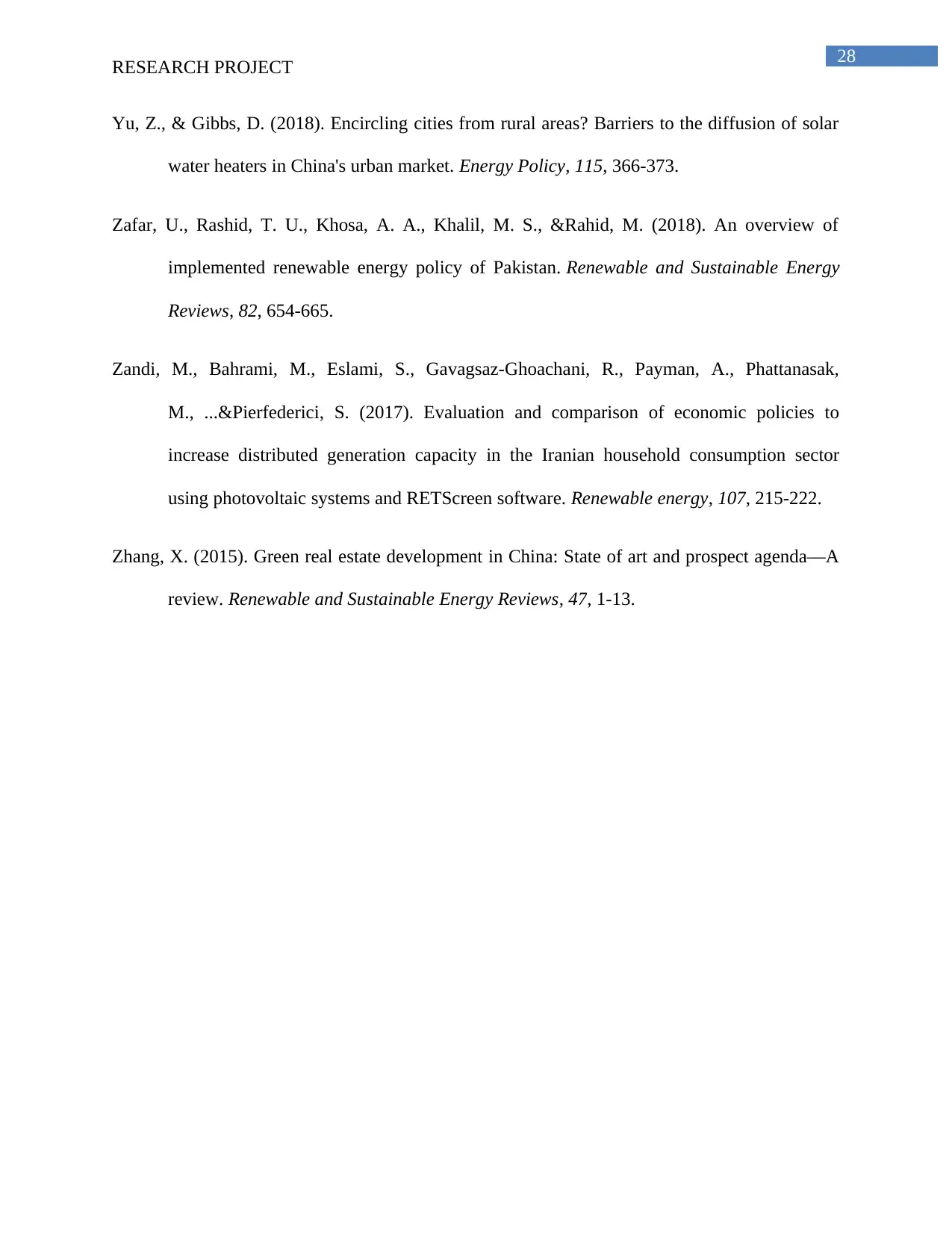
28
RESEARCH PROJECT
Yu, Z., & Gibbs, D. (2018). Encircling cities from rural areas? Barriers to the diffusion of solar
water heaters in China's urban market. Energy Policy, 115, 366-373.
Zafar, U., Rashid, T. U., Khosa, A. A., Khalil, M. S., &Rahid, M. (2018). An overview of
implemented renewable energy policy of Pakistan. Renewable and Sustainable Energy
Reviews, 82, 654-665.
Zandi, M., Bahrami, M., Eslami, S., Gavagsaz-Ghoachani, R., Payman, A., Phattanasak,
M., ...&Pierfederici, S. (2017). Evaluation and comparison of economic policies to
increase distributed generation capacity in the Iranian household consumption sector
using photovoltaic systems and RETScreen software. Renewable energy, 107, 215-222.
Zhang, X. (2015). Green real estate development in China: State of art and prospect agenda—A
review. Renewable and Sustainable Energy Reviews, 47, 1-13.
RESEARCH PROJECT
Yu, Z., & Gibbs, D. (2018). Encircling cities from rural areas? Barriers to the diffusion of solar
water heaters in China's urban market. Energy Policy, 115, 366-373.
Zafar, U., Rashid, T. U., Khosa, A. A., Khalil, M. S., &Rahid, M. (2018). An overview of
implemented renewable energy policy of Pakistan. Renewable and Sustainable Energy
Reviews, 82, 654-665.
Zandi, M., Bahrami, M., Eslami, S., Gavagsaz-Ghoachani, R., Payman, A., Phattanasak,
M., ...&Pierfederici, S. (2017). Evaluation and comparison of economic policies to
increase distributed generation capacity in the Iranian household consumption sector
using photovoltaic systems and RETScreen software. Renewable energy, 107, 215-222.
Zhang, X. (2015). Green real estate development in China: State of art and prospect agenda—A
review. Renewable and Sustainable Energy Reviews, 47, 1-13.
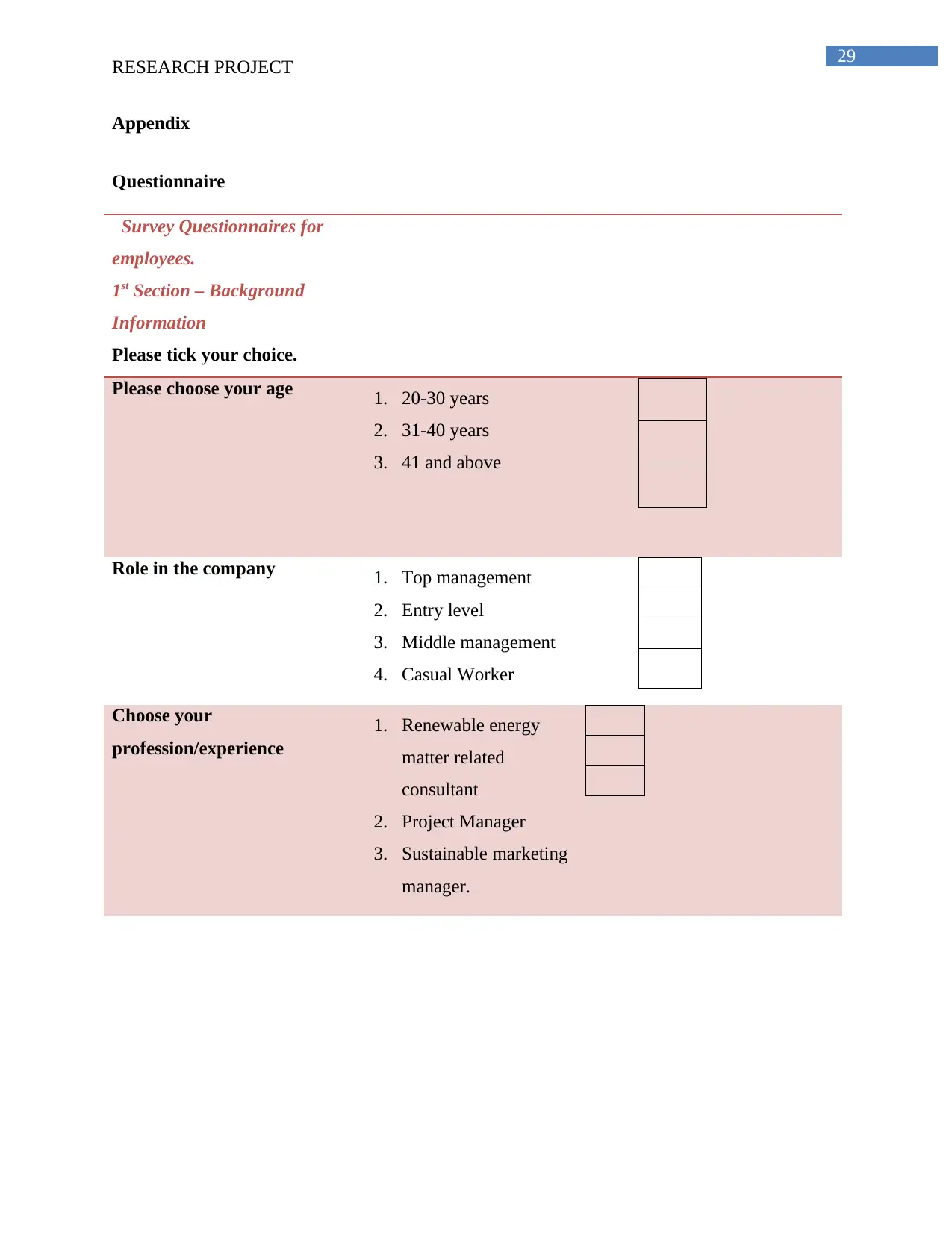
29
RESEARCH PROJECT
Appendix
Questionnaire
Survey Questionnaires for
employees.
1st Section – Background
Information
Please tick your choice.
Please choose your age 1. 20-30 years
2. 31-40 years
3. 41 and above
Role in the company 1. Top management
2. Entry level
3. Middle management
4. Casual Worker
Choose your
profession/experience
1. Renewable energy
matter related
consultant
2. Project Manager
3. Sustainable marketing
manager.
RESEARCH PROJECT
Appendix
Questionnaire
Survey Questionnaires for
employees.
1st Section – Background
Information
Please tick your choice.
Please choose your age 1. 20-30 years
2. 31-40 years
3. 41 and above
Role in the company 1. Top management
2. Entry level
3. Middle management
4. Casual Worker
Choose your
profession/experience
1. Renewable energy
matter related
consultant
2. Project Manager
3. Sustainable marketing
manager.
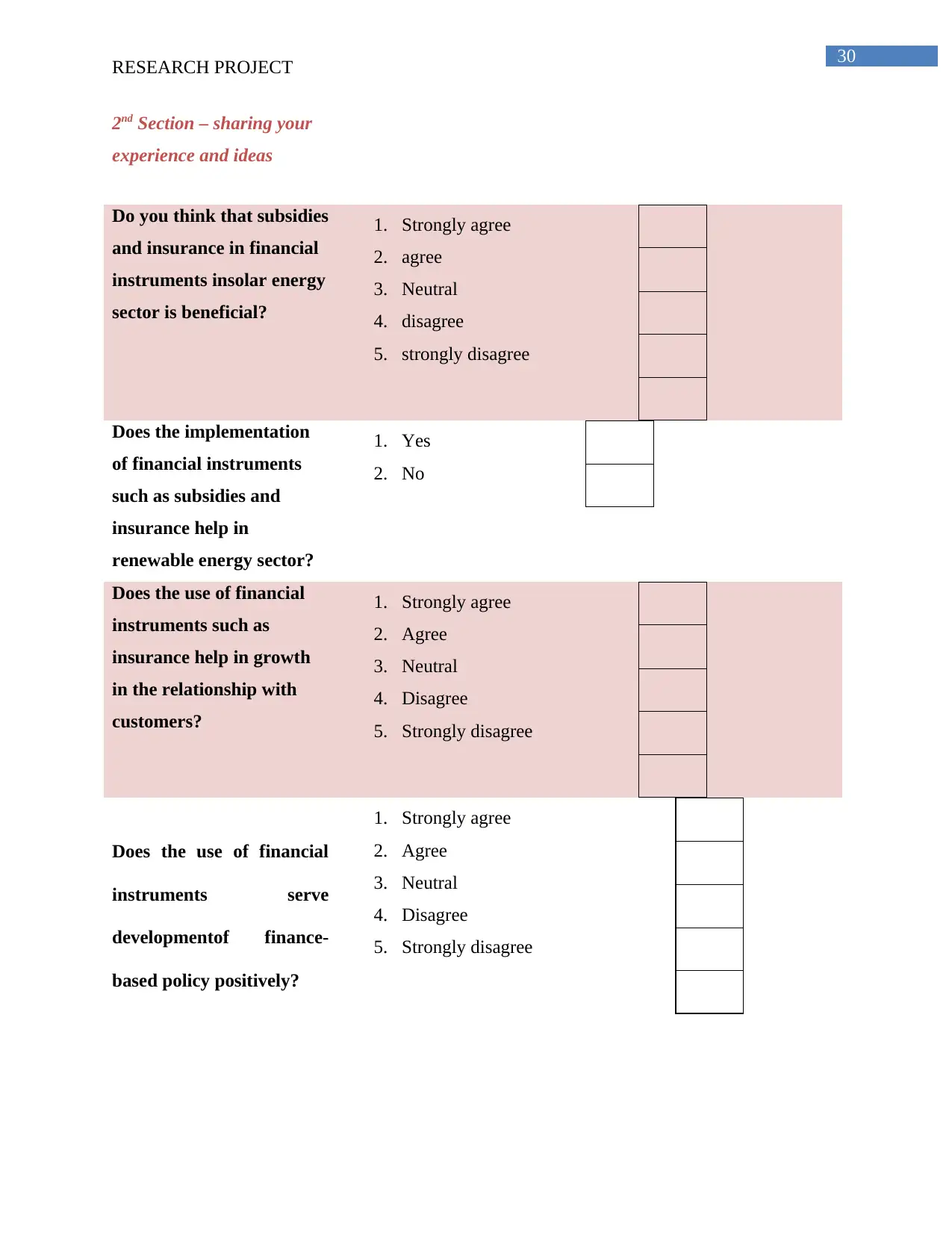
30
RESEARCH PROJECT
2nd Section – sharing your
experience and ideas
Do you think that subsidies
and insurance in financial
instruments insolar energy
sector is beneficial?
1. Strongly agree
2. agree
3. Neutral
4. disagree
5. strongly disagree
Does the implementation
of financial instruments
such as subsidies and
insurance help in
renewable energy sector?
1. Yes
2. No
Does the use of financial
instruments such as
insurance help in growth
in the relationship with
customers?
1. Strongly agree
2. Agree
3. Neutral
4. Disagree
5. Strongly disagree
Does the use of financial
instruments serve
developmentof finance-
based policy positively?
1. Strongly agree
2. Agree
3. Neutral
4. Disagree
5. Strongly disagree
RESEARCH PROJECT
2nd Section – sharing your
experience and ideas
Do you think that subsidies
and insurance in financial
instruments insolar energy
sector is beneficial?
1. Strongly agree
2. agree
3. Neutral
4. disagree
5. strongly disagree
Does the implementation
of financial instruments
such as subsidies and
insurance help in
renewable energy sector?
1. Yes
2. No
Does the use of financial
instruments such as
insurance help in growth
in the relationship with
customers?
1. Strongly agree
2. Agree
3. Neutral
4. Disagree
5. Strongly disagree
Does the use of financial
instruments serve
developmentof finance-
based policy positively?
1. Strongly agree
2. Agree
3. Neutral
4. Disagree
5. Strongly disagree
Paraphrase This Document
Need a fresh take? Get an instant paraphrase of this document with our AI Paraphraser
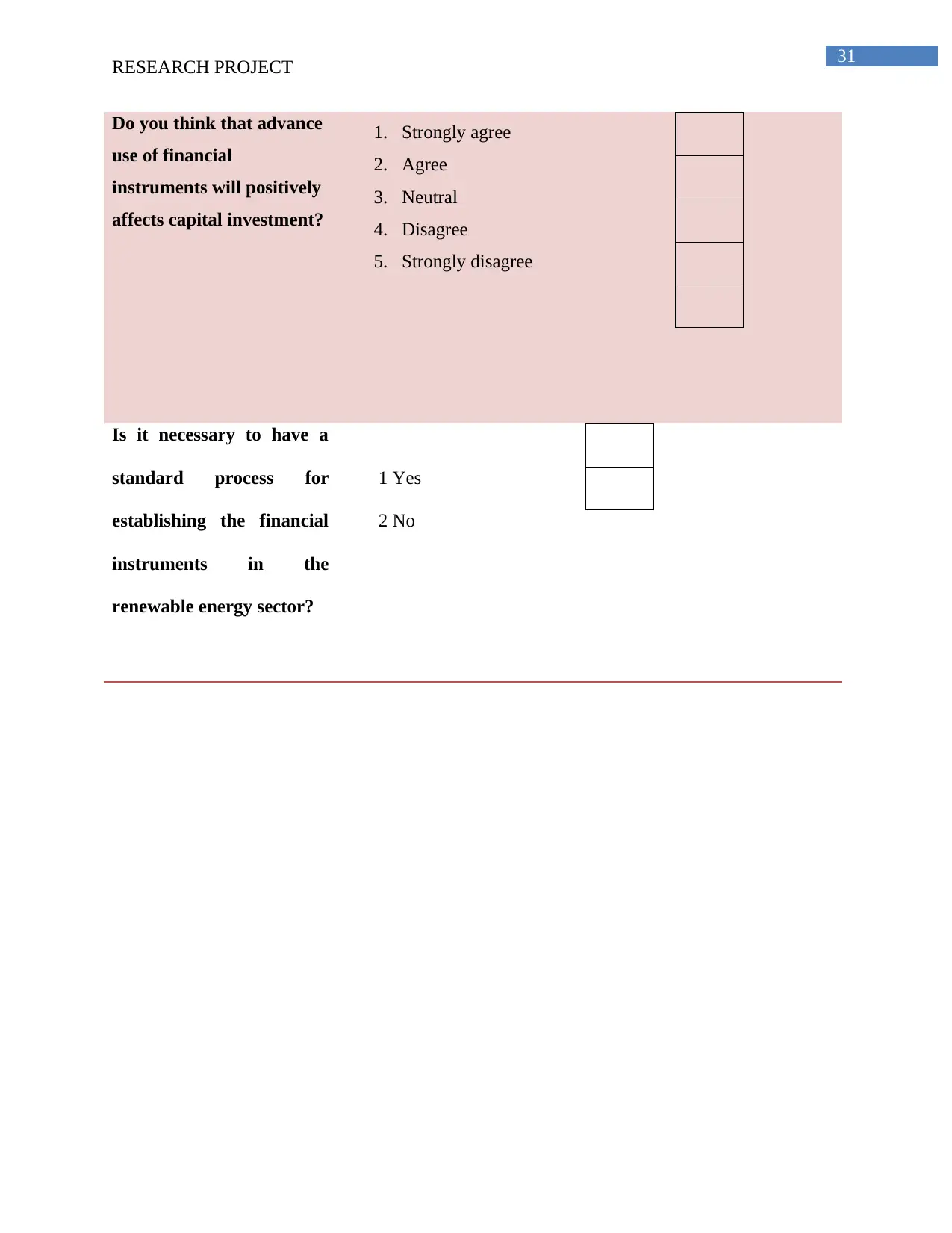
31
RESEARCH PROJECT
Do you think that advance
use of financial
instruments will positively
affects capital investment?
1. Strongly agree
2. Agree
3. Neutral
4. Disagree
5. Strongly disagree
Is it necessary to have a
standard process for
establishing the financial
instruments in the
renewable energy sector?
1 Yes
2 No
RESEARCH PROJECT
Do you think that advance
use of financial
instruments will positively
affects capital investment?
1. Strongly agree
2. Agree
3. Neutral
4. Disagree
5. Strongly disagree
Is it necessary to have a
standard process for
establishing the financial
instruments in the
renewable energy sector?
1 Yes
2 No
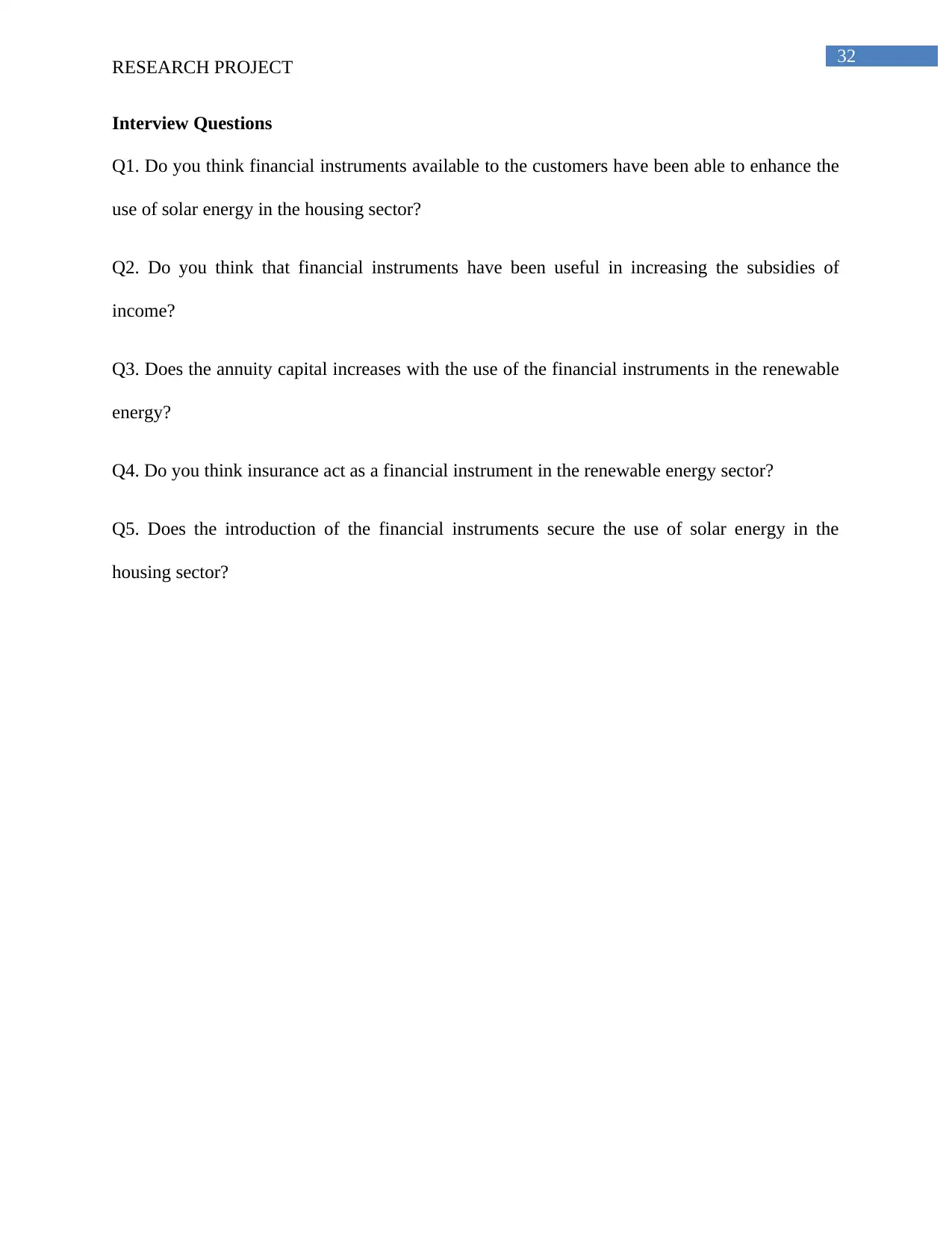
32
RESEARCH PROJECT
Interview Questions
Q1. Do you think financial instruments available to the customers have been able to enhance the
use of solar energy in the housing sector?
Q2. Do you think that financial instruments have been useful in increasing the subsidies of
income?
Q3. Does the annuity capital increases with the use of the financial instruments in the renewable
energy?
Q4. Do you think insurance act as a financial instrument in the renewable energy sector?
Q5. Does the introduction of the financial instruments secure the use of solar energy in the
housing sector?
RESEARCH PROJECT
Interview Questions
Q1. Do you think financial instruments available to the customers have been able to enhance the
use of solar energy in the housing sector?
Q2. Do you think that financial instruments have been useful in increasing the subsidies of
income?
Q3. Does the annuity capital increases with the use of the financial instruments in the renewable
energy?
Q4. Do you think insurance act as a financial instrument in the renewable energy sector?
Q5. Does the introduction of the financial instruments secure the use of solar energy in the
housing sector?
1 out of 33
Your All-in-One AI-Powered Toolkit for Academic Success.
+13062052269
info@desklib.com
Available 24*7 on WhatsApp / Email
![[object Object]](/_next/static/media/star-bottom.7253800d.svg)
Unlock your academic potential
© 2024 | Zucol Services PVT LTD | All rights reserved.

